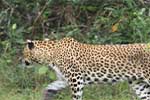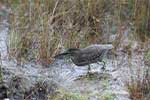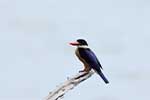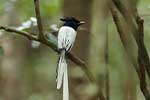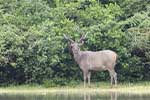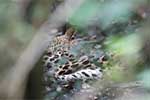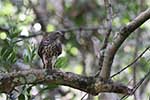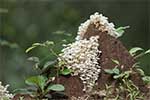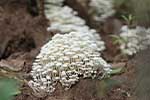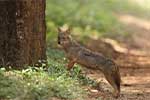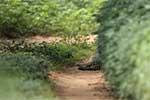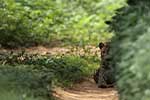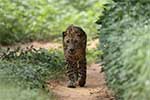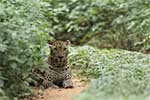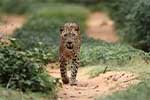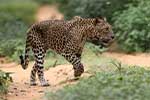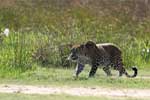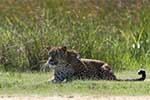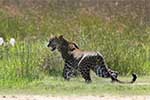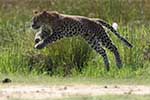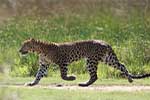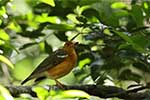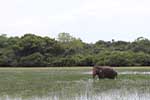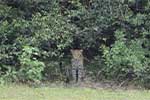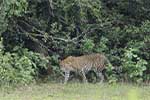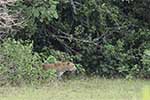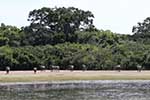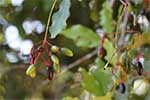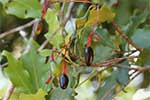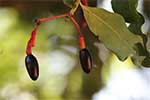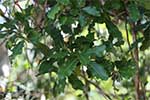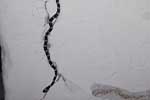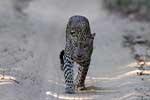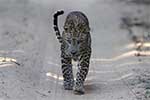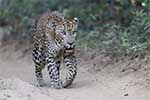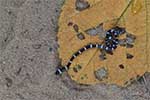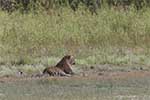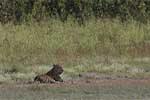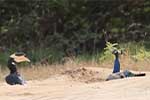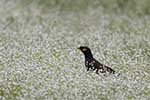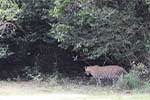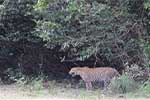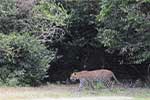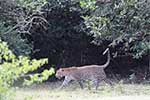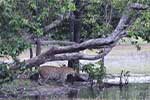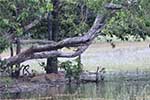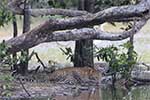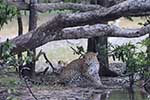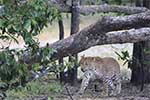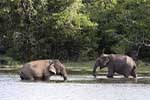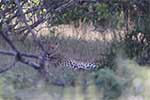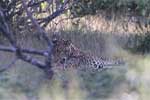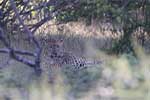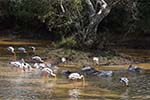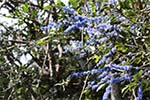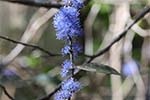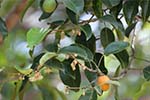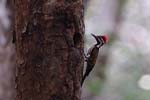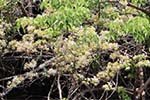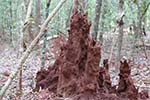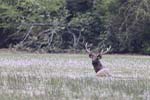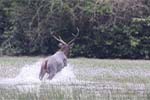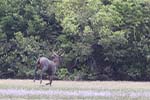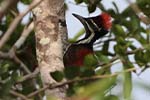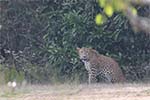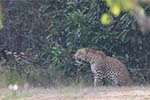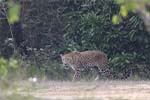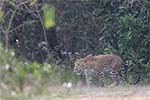
NOTES ON FIELD TRIPS TO WILPATTU NATIONAL PARK
- Wilpattu National Park 22nd to 23rd November 2024
-
2.00am 15 Spotted Deer in the garden.
6.30am 104 Spotted Deer and 3 Mugger Crocodiles at Hunuwilagama Tank.
8.50am entered the park.
8.52am a Ruddy Mongoose between park entrance and Konegaha Ela.
9.10am a Barking Deer between Percybendi Wewa and Thammanna Wala.
9.25am one Leopard about 200 meters from Palukola Wala. N 08.36191, E 080.09566
It was an adult female leopard. She was seated behind some bushed and was partly covered. As I brought the vehicle to a stop, she moved quickly into the forest. I only managed to get a few images of her left flank spot pattern, but to my utter disappointment the mages were of very low quality. I usually adjust the settings of my cameras to suit the light conditions of the day before entering the park. It was my misfortune that I had forgotten to adjust my camera settings to suite the overcast day. It was a heavy price to pay as it was the only leopard sighting for the day, and I had made a mess of it. The leopard was Palukola Wala Female 1 (PKWF 1). My only sighting of this elusive female was in October 2022 close to Thammanna Wala.
9.41am 2 Spotted Deer at Eda Kohomba gaha Pitiya.
10.12am 9 Spotted Deer between Galwanguwa and Maradanmaduwa.
10.17am a female Buffalo with a very recently born calf at Maradanmaduwa.
10.19am 55 Spotted Deer at Maradanmaduwa.
10.21am 12 more Spotted deer at Maradanmaduwa.
10.46am 4 Spotted deer stags between Borupan junction and Kumbuk Wila.
10.47am an adult male Wild boar between Kumbuk Wila sand patch and Kumbuk Wila.
10.49am 2 Golden Jackal at Kumbuk Wila pitiya.
10.55am it started to rain. Since it was a very heavy downpour, I decided to park at Thimbiri Wila and take a nap. The heavy rain continued for more than two hours.
1.18pm the heavy and continuous rain had had converted the roads into canals. Rainwater was gushing into these mini waterways from all directions. During such times I have often observed many aquatic forms of life such as Turtles, Fish Tadpoles and even baby Mugger Crocodiles use these water ways to disperse into new water bodies. Among the many Egrets and Herons that were seen hunting on the plains of Thimbiri Wila I observed a Little Green Heron. Even though this is a common species in wetlands and brackish water habitats it is a rarely seen species in the main villu areas of the park.
1.22pm a Sambhur at Thimbiri Wila.
1.27pm 27 Spotted Deer at Mahapatessa.
1.35am 35 Spotted Deer at Kokkare Villu.
1.44am 14 Spotted Deer at Nelum Wila Pitiya.
2.00pm a Sambhur stag with an impressive pair of symmetrical antlers at Kokkare Villu.
2.01pm 7 Spotted Deer at Kokkare Villu.
2.07pm 7 Spotted Deer at Kuruttupandi Villu.
3.09pm 34 Spotted Deer at Kumbuk Wila Pitiya.
3.52pm 2 Spotted Deer and a Star Tortoise on Maha Wewa Road.
3.53pm another Star Tortoise on Maha Wewa Road.
4.00pm 2 Buffalo on Maha Wewa Road.
4.05pm a pair of Bustard Quail on Maha Wewa Road.
4.24pm a Sambhur between Maha Wewa and Maradanmaduwa.
4.39pm two adult female sambhur with a calf at Galwanguwa.
5.03pm 14 Spotted Deer between Thammanna Wala and Kukulkatuwa Junction.
5.05pm a Buffalo between Kukulkatuwa and Kukulkatuwa junction.
5.39pm one Elephant between Konegaha Ela and Park Entrance.
5.50pm left the park.
7.58pm alarm calls of Sambhur and Spotted Deer across the Hunuwilagama tank.
8.40am a lone bull Elephant walked through the garden on to the tank bund.
Mammals and Reptiles observed during the day.
Mammals – Elephant 2, Leopard 1, Indian Buffalo 5, Sambhur 6, Spotted Deer 341, Wild Boar 1, Barking Deer 1, Golden Jackal 2, Ruddy Mongoose 1, Toque Monkey, Grey Langer, Giant Squirrel, Indian Palm Squirrel.
Reptiles – Mugger Crocodile 3, Flapshell Turtle , Black Turtle 6, Star Tortoise 2, Land Monitor, Common Garden Lizard, Low-land Kangaroo Lizard, Devaka’s Fan-throat Lizard.
23rd November 2024
Whole of yesterday was overcast with intermittent heavy rains. However, the gloomy conditions cleared up resulting in a star-studded night. The Hunuwilagama Tank was beathed in a blanket of heavy mist in the morning which slowly cleared up around 7.00am.
6.50am 57 Spotted Deer at the Hunuwilagama Tank.
7.14am entered the park.
7.15am a Barking Deer between the park entrance and Konegaha Ela.
7.17am a Golden Jackal at Ranawara Pitiya.
7.57am 3 Spotted Deer at “Eda Kohombagaha pitiya”
8.00am 3 Spotted Deer and a Buffalo at Maradanmaduwa.
8.04am 5 more Spotted Deer at Maradanmaduwa.
8.24am a large Mugger Crocodile at Walas Wala.
8.31am 2 Ruddy Mongoose at Kumbuk Wila sand patch.
8.34am 27 Spotted Deer at Kumbuk Wila.
8.35am 8 more Spotted Deer at Kumbuk Wila.
8.40am 2 Spotted Deer at Kokkare Villu.
8.55am a Black-capped Purple Kingfisher at Kokkare Villu. Since 2013 this seldom seen rare migrant species has been sighted in Wilpattu during most migrant seasons.
9.21am a sounder of 5 Wild Boar Manik Wila.
9.23am an Indian Cuckoo on the upper road at Manik Wila.
10.27am 9 Spotted Deer at Mana Wila.
11.03am a Ruddy Mongoose between Mana Wila and Mana Wila sand patch.
11.04am 2 more Ruddy Mongoose at Mana Wila sand patch.
12.25pm a male Indian Paradise Flycatcher at Thammannagaha Junction on the Kokkare Villu upper road.
12.32pm 15 Spotted Deer at Nelum Wila.
12.47pm 3 Spotted Deer stags ran across the road between Panikkar Villu and Kombansanchaipooval.
12.51pm a Barking Deer at Kombansanchaipooval sand patch.
12.53 pm 5 Spotted Deer and a Ruddy Mongoose at Tala Wila.
12.54pm the roads around Tala Wila were all submerged. The water level had reached the edge of the forest. I had not observed such a volume of water at this water body during my study since 2012. 4 large Mugger Crocodiles that had moved to the edge of the forest swam hurriedly back upon the arrival of my vehicle.
1.30pm a Flapshell Turtle at Tala Wila.
1.33pm another Flapshell Turtle at Tala Wila.
1.37pm a large Mugger Crocodile at Kombansanchaipooval.
1.59pm 11 Spotted Deer at Nelum Wila pitiya.
3.07pm 29 Spotted Deer at Mahapatessa.
3.28pm a Flapshell Turtle at Manikrala uraniya.
4.11pm 6 Spotted Deer at Kumutu Wila.
4.22pm 17 Spotted Deer and one Sambhur at Kanjuran Villu.
4.43pm one leopard at Manik Wila. N 08.45600, E 079.98094
It was an adult male leopard that was lying inside the forest at the foot of a termite hill. It was concealed by the foliage. I managed to get a few images which enabled me to see the spot pattern on the left side of its face. It was Nelum Wila Male 5 (NWMC 5), the dominant male in the main villu area of the park.
4.47pm one Elephant at Manik Wila.
5.26pm a Sambhur between Galwanguwa and the Sohon Pitiya pond.
6.00pm left the park.
Mammals - Elephant 1, Leopard 1, Indian Buffalo 1, Sambhur 2, Spotted Deer 200, Wild Boar 5, Barking Deer 2, Golden Jackal 1, Ruddy Mongoose 6, Toque Monkey, Grey Langer, Giant Squirrel, Indian Palm Squirrel.
Reptiles – Mugger Crocodile 6, Flapshell Turtle 3, Black Turtle 5, Land Monitor, Common Garden Lizard, Low-land Kangaroo Lizard, Devaka’s Fan-throat Lizard.
Birds, Butterflies & Flora observed during the field trip.
Birds – Black-capped Purple Kingfisher, Lesser Adjutant, Painted Storks, White-necked Stork, Indian Cuckoo, Orange-headed Ground Thrush, Indian Pitta, Little Green Heron, Forest Eagle Owl, Little Green Heron, Bustard Quail
Butterflies - Common rose Pachliopta aristolochiae, Crimson Rose Pachliopta hector
Wild Orchids – Taprobanea spathulate, Vanda tessellate
Fruiting Trees - Guru Keena (S) Calophyllum calaba, Moona Mal (S) Spanish Cherry Tree (E) Mimusops elengi, Wal Waraka (S) Casearia zeylanica, Ila Paththa (S) Maba buxifolia
Wildflowers – Bauhinia tomentosa Yellow Orchid Tree (E) Yellow Bell Bauhinia (E) Kaha Pethan (S), Canavalia virosa Sword Bean (E) Jack Bean (E) Mudu Awara (S), Catunaregam spinosa Common Emetic (E) Emetic Nut (E) Kukuruman (S), Crinum defixum Ker Gawl (E) Heen-tolabo (S), Crotalaria laburnifolia Bird Flower (E) Yak-beriya (S), Gloriosa superba Flame Lily (E) Glory Lily (E) Niyangala (S), Gmelina asiatica Asiatic Bushbeech (E) Demata (S), Hibiscus eriocarpus Maple-leaved Mallow (E) Kapukinissa (S) Wal Wada (S),
- Wilpattu National Park 1st to 3rd November 2024
-
6.45am 57 Spotted Deer and 5 large Mugger Crocodiles at Hunuwilagama Tank.
8.06am entered the park with my friend Chandima Kahandawela.
4 Spotted Deer at the park entrance.
8.14am 4 more Spotted Deer between Konegaha Ela and Ranawara Pitiya.
8.15am photographed a small tree which belong to Ochna sp. bearing bright red fruits. The sepals were also bright red. These trees are commonly referred to as “Micky Mouse” trees due to the flowers and the sepals resembling the famous Disney World cartoon character.
8.24am one Ruddy Mongoose between Ranawara Pitiya and Percy Bendi Wewa.
8.33am 4 Spotted Deer and a sub adult Mugger Crocodile at Thammanna Wala.
8.39am one Spotted Deer antler on Maha Wewa Road.
8.40am 3 more Spotted Deer between Thammanna Wala and Kukulkatuwa junction.
8.44am 4 Spotted Deer between Kukulkatuwa Junction and Maha Wewa.
8.48am 2 more Spotted Deer between Kukiulkatuwa Junction and Maha Wewa.
8.59am a sounder of 12 Wild Boar, 18 Buffalos and 24 Spotted Deer at Maha Wewa.
9.09am 14 Spotted Deer accompanies by a troop of Grey Langur at Maha Wewa.
9.12am 2 Indian Grey Mongoose and 12 Spotted Deer at Maha Wewa.
8.14am 16 Spotted Deer, a sounder of 14 Wild Boar and one more Buffalo at Maha Wewa.
9.20am 41 more Spotted Deer at Maha Wewa.
9.22am a sub adult Shikra captured a large dragonfly. The small hawk perched on a branch and fed on the insect permitting me to get a few images. Having fed the hunter vigorously rubbed its beak on the branch before flying off.
This is a breeding resident species found throughout the country. It is a small bird of prey, which is distributed throughout Asia and Africa. Six subspecies have been recognized and the nominate form Accipiter badius badius is found only in Sri Lanka.
This is common garden bird in the city of Colombo. I observe them very regularly in my home garden. The small hunter is always around our garden attracted by the many species of small birds that visit the little patch of forest and the bird feeders. In my garden I have observed this species feeding on the Common Garden Lizards Calotes versicolor and many species of small birds including Purple-rumped Sunbirds, White-backed Munia, immature Magpie Robin and Rose-ringed Parakeet. I have seen this species to be common in urban areas, open country, Montane Forests, wet zone forests, home gardens and the dry lowland forests. In the north I have found them to be common in the Mannar Island and the Jaffna Peninsula. In 2011 I observed the Shikra even in the Delft Island.
It is a common species found all over the park. I have often seen them between the park entrances to Maradanmaduwa.
9.24am another sounder of 16 Wild Boar at and a troop of Grey Langur Maha Wewa.
9.36am 2 more Spotted Deer at Mahah Wewa.
9.52am 5 Spotted Deer between Maha Wewa and Maradanmaduwa.
9.54am 2 Sambhur between Maha Wewa and Maradanmaduwa.
9.55am 3 more Spotted Deer between Maha Wewa and Maradanmaduwa.
9.56am a Cobra on the road between Maha Wewa and Maradanmaduwa.
9.57am a troop of Grey Langur between Maha Wewa and Maradanmaduwa.
10.04am 8 Spotted Deer between Maha Wewa and Maradanmaduwa.
10.05am 5 Spotted Deer between Maha Wewa and Maradanmaduwa.
10.06am 3 more Spotted Deer between Maha Wewa and Maradanmaduwa.
10.16am a Ruddy Mongoose at Maradanmaduwa.
10.19am 7 Spotted Deer at Maradanmaduwa.
10.22am 9 Spotted Deer at the “Kukul Katu Pitiya” at Maradanmaduwa.
10.23am 4 more Spotted Deer at Maradanmaduwa.
10.27am Termite Mushrooms Termitomyces microcarpus photographed on a large termite nest between Mahawewa and Maradanmaudwa. In Sinhala these mushrooms are referred to as “Heenwaliya”.
This is a species which belong to the Lyophyllaceae family and is found in most regions in Africa and Asia. They grow on or close to termite hills from which its common name is derived. All the species of this genus are edible, and the above species is said to contain a large amount of total amino acids as well as essential amino acids. The Termite Mushroom is regularly used by many indigenous people to treat a variety of ailments across Africa and Asia.
Interestingly the reason why this species is always is found in association with termite hills is due to a unique symbiotic relationship that exits between the two species. The termites provide a protective environment for the body of the fungus (Mycelium) by cultivating it inside their colony on their foraged plant material. In return the fungus helps the termites to degrade the plant-derived material such as wood, dry stems of grasses, and leaf litter etc on which they feed to obtain cellulose. One of the most captivating sights in terms of Mushrooms in Wilpattu is to see large termite hills covered by thousands of these tiny nail head sized mushrooms. I have photographed them during the months of October to December at many locations from the park entrance to Phill Motte.
10.29am 4 Spotted Deer stags at Thambioluwa.
10.32am 8 Buffalo at Ibba Wala.
10.50am 2 Golden Jackal Between Borupan Junction and Kumbuk Wila sand patch. They were trotting in our direction but moved into the forest upon detecting the parked vehicle. This is the third largest carnivore in the country after the Leopard and the Sloth Bear. There is a belief among the guides and safari Jeep Drivers in Wilpattu that seeing Jackals running towards you will always result in a good leopard sighting. I told Chandima that during the 13 years I had been visiting the park there had been some days where I have not seen leopards despite seeing Jackals and days where Jackal sightings had not resulted in any leopard sightings. However, there have also been many days where this belief had come right as well.
Twelve subspecies of this interesting species have been recognized in the world. They are found from North and North-east Africa to Indochina. The Golden Jackal occur in Senegal, Morocco, Algeria, Tunisia, Libiya, Nigeria, Chad, Tanzania, countries in the Arabian Peninsula, Western Europe, to Bulgeria, Austria, Italy, Turkey, Syria, Iran, Iraq, Central Asia, Indian Subcontinent, Myanmar, Thailand and Indochina.
This species has been recorded at an elevation of 3800 meters in Ethiopia and is said to be common at altitudes of approximately 2000 meters in India. However, in Sri Lanka even though Golden Jackals are occasionally reported from altitudes of 2000 meters in the hills and are found in small numbers in the wet zone areas, it is primarily an animal of the open areas of the dry zone. I have heard the call of this species, which is an ascending wailing howl, at night at Athwelthota and Bandarawela in the wet zone and observed one at Maharagama, just outside Colombo, on the main road close to a rubbish dump around mid-night in May 1999. In populated areas the Jackal has altered its behavior to be mostly nocturnal, however in almost all the Dry Zone National Parks they are commonly seen during the day. In January 2000 at Udawalawa National Park I counted 21 Golden Jackals, which is the highest I have counted within a day at a National Park. Even though Golden Jackals are often seen scavenging and feeding on carrion they are opportunistic animals that can survive on an omnivorous diet and when in a group, engage in hunting as well. In Wasgomuwa National Park once I observed 6 Jackals working together in successfully separating a Spotted Deer fawn from its mother, killing it and feeding on the carcass. When I arrived the female Spotted Deer and the fawn were in an open glade and were not accompanied by a herd. The fawn had fresh wounds and was bleeding. While two Jackals kept on harassing the doe and chased it away, the others held on to the fawn and continued to bite it viciously. Even though the doe on a few occasions tried to approach the fawn that was crying out, the two jackals kept on circling her and she gave up and ran into the forest. Thereafter all six of them attacked the injured fawn and killed it quickly. Even though there were many squabbles between them while feeding they all fed on the carcass. I was not able to wait until the end, as I had to leave to reach the park entrance by 6.30 p.m.
In Wilpattu Golden Jackal is not uncommon and can be seen throughout the park. They are usually seen in pairs and sometime in small family groups of about four. I have seen them at many locations including Hunuwilagama, Maradanmaduwa, Kuruttupandi Villu, Borupan Wila, Panikkar Villu, Tala Wila, Kokkare Villu and Mahapatessa.
10.55am 4 Spotted Deer and a sounder of 16 Wild Boar at Kumbuk Wila pitiya.
11.00am 4 Spotted Der at Mandangas Wala.
12.12pm 7 Spotted Deer at Nelum Wila.
12.17pm 17 Spotted Deer on Kokkare Villu upper road.
12.37pm 3 Spotted Deer at Kumutu Villu.
1.04pm 5 Spotted Deer between Kanjuran Villu and Kaali Villu.
1.58pm 1 Leopard at Kattarambu Villu. N 08.50997, E 079.99141
As we approached Kattarambu Villu, I noticed what looked like the front parts of the paws of a sleeping leopard about 50 meters ahead of us where the road was curving to the right. A look through the binoculars confirmed that it was indeed a leopard. I immediately switched off the engine as leopards, in these less visited areas of the park, are usually not very tolerant of vehicles and often quickly disappear into the forest upon seeing a vehicle during the day. As he was lying on the road at a point where the road curved to the right his body was well concealed by the Dry Zone Purple Bell Stenosiphonium cordifoliumshrubs growing gregariously on either side the road. These shrubs made it impossible to get any images of the leopard despite being able to observe his movements through the lens of my camera. He was quite alert and was looking intently in our direction through the shrubs. After about 8 minutes the curious leopard moved his head and looked at us offering a clear view of its face. It was a mature male leopard, and I estimated its age to be about 7 years. By this time, his facial expressions indicated that he was relaxed. After some time, our patience paid off when he stood up and took a few steps in our direction and lied down again in full view. I gathered that he wanted to walk in our direction. Thus, having got a few images and Chandima capturing him on video we decided to reverse the vehicle about 300 meters until the leopard was out of sight and waited in expectation of the leopard emerging from the curved road. A few anxious minutes passed and all at once the leopard appeared on the road again permitting us to capture him at a much closer distance than earlier. As he saw the vehicle he stopped and laid on the road again. This time he was about 30 meters from us. He appeared more relaxed than before but kept his distance. We revered again and watched him walk in our direction. After some time, something in the jungle caught his attention, and the magnificent leopard moved into the forest. Both of us were elated with the sighting and Chandima mentioned that the Jacal theory of Wilpattu yielded positive results after all. We drove down and noted that he had walked from Nabada Wila. I have kept records of this elusive leopard from August 2020 with the help of images shared with me by others who contribute to my study. Most of these sightings were made towards late evenings by those who were staying overnight in park bungalows. This is my first sighting of this leopard. To aid my study, I named him Kattarambu Male 1 with the code KRM 1.
3.07pm 3 Spotted Deer at Manan Wila.
3.35pm 6 Spotted Deer at Eriyakkulampooval.
3.37pm 12 Spotted Deer at Mahapatessa
3.48pm 15 Spotted Deer at Kokkare Villu.
4.29pm 17 Spotted Deer on Kokkare Villu upper road.
4.45pm 27 Spotted Deer, a sounder of 12 Wild Boar and one Elephant at Kumbuk Wila.
4.53pm one Sambhur at Walas Wala.
5.08pm 3 Buffalo at Maradanmaduwa.
5.10pm 48 Spotted Deer at “Kukul Katu Pitiya” in Maradanmaduwa.
5.12pm 26 Spotted Deer and a Black-naped Hare at Maradanmaduwa.
5.24pm a Buffalo at Palu Kola Wala.
6.00pm left the park.
Mammals and Reptiles observed during the day.
Mammals – Elephant 1, Leopard 1, Indian Buffalo 32, Sambhur 3, Spotted Deer 415, Wild Boar 70, Golden Jackal 2, Black-naped Hare 1, Ruddy Mongoose 2, Grey Mongoose 2, Giant Squirrel, Indian Palm Squirrel.
Reptiles – Mugger Crocodile 6, Black Turtle 7, Land Monitor, Common Garden Lizard, Low-land Kangaroo Lizard, Devaka’s Fan-throat Lizard, Indian Cobra 1
2nd November 2024
6.30am 45 Spotted deer and about 7 Mugger Crocodiles at Hunuwilagama Tank.
8.13am entered the park.
8.40am 2 Ruddy Mongoose and 3 Spotted Deer at Thammanna Wala glade.
8.43am 3 more Spotted Deer between Thammanna Wala and Divul Pitiya.
8.57am 8 Spotted Deer at Maradanmaduwa.
8.59am 48 Spotted Deer at Maradanmaduwa.
9.15am a Barking Deer between Humbas Wala and Walas Wala.
9.17am one Sambhur between Humbas Wala and Walas Wala.
9.30am a sounder of 12 Wild Boar at Madangas Wala.
9.45am one Leopard at Nelum Wila Pitiya. N 08.40593, E 079.98786
I dove into Nelum Wila pitiya and observed several vehicles parked ahead of me as they had spotted two leopards in the thicket. I parked at the back expecting the leopards to move out into the open. Within a few minutes a Palm Squirrel started to give out an alarm call from across the open glade and a young male leopard was seen across the “pitiya”. He moved in the direction where the other two leopards had been seen. I managed to get some images as the leopard hurriedly walked and leapt over a small pool of water. It was quite evident from his behaviour that the cub was responding to its mother’s call. Female leopards employ a low frequency growl to call their cubs. Later upon examining its spot pattern I noted that it is one of the two cubs of Nelum Wila Female 2 NWF 2. I have received images of two cubs of this female since they were first seen in October 2023 but had not seen them until today. They are one year and four months of age now. As it is my first sighting of this young leopard, I named it Nelum Wila Pitiya Male 2 with the code NWPMC 2.
10.33am 11 Spotted Deer at Kokkare Villu.
10.40am an Orange-headed Ground Thrush that was on the road flew up on to a tree with my arrival between Kokkare Villu and Kuruttupandi Villu. This rare migrant species is regularly seen in the park during the migrant season.
During the migrant season it can be found throughout the low country up to the mid hills. This secretive species inhabits shady damp areas of the forest and usually hops out into the open during dawn and dusk. I have seen it at most dry zone national parks including Udawalawa, Wasgomuwa, Yala and Kumana.
It is a regularly seen species at Wilpattu during the early morning and evening game drives. I have seen it at many locations in the park including Hunuwilagama, Aalam Villu, Panikkar Villu, Maradanmaduwa and Tala Wila. The wastewater drains from the kitchens of most park bungalows are invariably visited by these birds to feed on worms and other insects during dawn and dusk.
10.55am two Spotted Deer at Illanda Motte.
11.03am 5 Spotted Deer between Downall Pitiya and Mana Wila sand patch.
11.04am 6 more Spotted Deer Downall Pitiya and Mana Wila sand patch.
11.55am 4 Spotted Deer at Kattarambu Villu.
1.01pm 8 Spotted Deer at Manik Wila.
1.07pm 2 Spotted Deer at Kumutu Wila.
1.14pm 5 Spotted Deer at Kanjuran Villu.
1.17pm a Ruddy Mongoose between Kanjuran and Kaali Villu.
2.11pm one Elephant at Kanjuran Villu.
2.19pm 9 more Spotted Deer at Kumutu Villu.
2.28pm 4 Spotted Deer and a Black-naped Hare at Kokkare Villu.
2.30pm it started to rain. The park receives heavy rains from October until mid-December. Considering the downpour I decided to leave the park. The rain converted most roads into waterways within a very short time.
3.44pm 2 Spotted Deer at Divul Pitiya.
3.47pm a Black-naped Hare at Thammanna Wala glade.
4.02pm left the park.
4.45pm I observed the family of Malabar Pied Hornbills that frequent the home garden arriving at the feeding station. The two chicks are not fed by the parents now. They fed on the bananas and left over rice hungrily.
5.30pm A Ruddy Mongoose arrived at the feeding station.
6.10pm a Small Indian Civet, commonly referred to as the Ringed-tailed Civet walked up to the feeding station.
6.20pm two Mouse Deer and a Common Palm Civet in the garden.
10.40pm 2 Elephants walked down from the tank bund and walked through the garden in the direction of the village.
Mammals - Elephant 3, Leopard 1, Sambhur 1, Spotted Deer 158, Wild Boar 12, Barking Deer 1, Ruddy Mongoose 4, Black-naped Hare 2, Toque Monkey, Grey Langer, White – spotted Chevrotain 2, Common Palm Civet 1, Small Indian Civet 1, , Giant Squirrel, Indian Palm Squirrel.
Reptiles – Mugger Crocodile 7 , Black Turtle 4, Star Tortoise, Land Monitor, Common Garden Lizard, Painted-lip Lizard, Low-land Kangaroo Lizard, Devaka’s Fan-throat Lizard.
3rd November 2024
7.10am entered the park.
7.34am 4 Spotted Deer at Percy Bendi Wewa.
7.39am one Barking deer between Paaluwinlandawa junction and Thammanna Wala.
7.58am a herd of 7 water Buffalo at Galwanguwa.
8.04am 17 Spotted Deer at Maradanmaduwa.
8.05am 27 more Spotted Deer at Maradanmaduwa.
8.22am a Ruddy Mongoose between Boralu Wala and Walas Wala.
8.37am one Elephant and 15 Spotted Deer at Kumbuk Wila.
8.54am 3 Spotted Deer at Kokkare Villu.
8.57am one Ruddy Mongoose on Kokkare Villu upper road.
9.27am a large Mugger Crocodile that was lying on the road walked to the water at Kumutu Villu.
9.37am 12 Spotted Deer at Kanjuran.
9.40am a Barking Deer between Kanjuran and Kaali Villu.
10.25am a Sambhur at Downall Pitiya.
10.26am a Flapshell Turtle at Dowall Pitiya.
10.42am one adult male Wild Boar between Thelambugas Wala (Herath Hamy Wala) and Kattapambu Villu.
11.00am 12 Spotted Deer and a Ruddy Mongoose at Kattarambu Villu.
11.29am a Ruddy Mongoose on Kuruttupandi upper road.
1.00pm one young male leopard at Kumbuk Wila pitiya. N 08.42103, E 080.01031
Upon receving information that a leopard had been seen many vehicles had gathered at Kumbuk Wila pitiya. I kept observing the forest edge for any signs of the leopard and spotted the leopard moving out of the forest. Having alerted the other by flashing the head lights I started to get a few images. It was a young male leopard. Later upon examining the spot patterns I noted that this is Kumbuk Wila Male 3 KWMC 3, one of the two cubs of Kumbuk Wila Female 2 KWFC 2 populerly referred to as “Cleopatra”.
1.54pm 22 Spotted Deer at Nelum Wila.
1.56pm 9 more Spotted Deer at Nelum Wila.
2.00pm. The overcast heavy dark clouds over Wilpattu finally gave way, and a heavy down pour started.
2.53pm 5 Spotted Deer at Thammanna Wala glade.
2.57pm a Maroon & Gold Land Crab between Thammanna Wala and Percy Bendi Wewa.
3.11pm left the park.
5.10pm counted 106 Spotted Deer, one Wild Boar and 8 large Mugger Crocolies at Hunuwilagama Tank.
Mammals - Elephant 1, Leopard 1, Indian Buffalo 7, Sambhur 1, Spotted Deer 233, Wild Boar 2, Barking Deer 2, Ruddy Mongoose 4, Toque Monkey, Grey Langer, Giant Squirrel, Indian Palm Squirrel.
Reptiles – Mugger Crocodile 8, Flapshell Turtle 1, Black Turtle 7, Land Monitor, Common Garden Lizard, Painted-lip Lizard, Low-land Kangaroo Lizard, Devaka’s Fan-throat Lizard, Indian Cobra
Birds, Butterflies & Flora observed during the field trip.
Birds – Lesser Adjutant, Painted Storks, White-necked Stork, Orange-headed Ground Thrush, Large-billed and Green Leaf Warblers, Indian Pitta, Indian Cuckoo
Butterflies - Common Tinsel, Blue Mormon, Common Moron, Crimson Rose, Red Spot Duke, Great Orange Tip, Quaker, Leopard, Blue Wanderer.
Wild Orchids – Taprobane spathulate, Vanda tessellate, Vanilla walkerae
Fruiting Trees - Moona Mal (S) Spanish Cherry Tree (E) Mimusops elengi
Wildflowers – Canavalia virosa Sword Bean (E) Jack Bean (E) Mudu Awara (S), Crinum defixum Ker Gawl (E) Heen-tolabo (S), Hugonia mystax Climbing Flax (E) Gini Kitiya (S) Bu Getiya (S), Hibiscus eriocarpus Maple-leaved Mallow (E) Kapukinissa (S) Wal Wada (S)
- Wilpattu National Park 5th to 6th October 2024
-
6.20am 78 Spotted Deer and 7 large Mugger Crocodiles at Hunuwilagama tank.
7.11am entered the park.
7.12am 7 Spotted Deer between park entrance and Kone Gaha Ela.
7.17am a Barking Deer and 4 Spotted Deer at Ranawara Pitiya.
7.19am 2 Ruddy Mongoose between Ranawara Pitiya and Percy Bendi Wewa.
8.31am 29 Spotted Deer at Kumbuk Wila.
8.32am 30 Spotted Deer between Kumbuk Wila and Kokkare villu.
8.36am 3 Spotted Deer stags on Kokkare villu upper road.
8.41am 8 Spotted Deer at Nelum Wila.
8.54am 2 Ruddy Mongoose at Nelum Wila pitiya.
8.59am 2 more Spotted Deer on Kokkare villu upper road.
9.09am a sounder of 11 Wild Boar at Kokkare Villu upper road.
9.16am another sounder of 17 Wild Boar at Kumbuk Wila upper road.
9.22am 10 Buffalo at Thimbiri Wila.
9.36am one Elephant at Borupan Wila.
9.54am 2 Spotted Deer on Lunu Wewa road.
10.20am Upon receiving information that a leopard was seen in the morning and that it is sleeping beneath same tree I waited at Borupan Wila pitiya until 3.30pm expecting the leopard to move out but it was in vain.
4.45pm one leopard at Kumbuk Wila pitiya. N 08.42108, E 080.01014
The young leopard had climbed a Palu Tree and was concealed by the branches. I managed to get a few images as the cat changed its position on the branch where the spot pattern of its head could be identified. It was one of the second litter male cubs of Kumbuk Wila Female 2, popularly referred to as Cleopatra. As this is my first sighting of this leopard, I named it Kumbuk Wila Male 3 with the code KWMC 3 for the purpose of my study. 5.55pm left the park.
Mammals and Reptiles observed during the day.
Mammals – Elephant 1, Leopard 1, Indian Buffalo 10, Spotted Deer 175, Wild Boar 28, Barking Deer 1, Ruddy Mongoose 4, Toque Monkey, Grey Langer, Giant Squirrel, Indian Palm Squirrel.
Reptiles – Mugger Crocodile 8, Parker’s Black Turtle 6, Land Monitor, Common Garden Lizard, Low-land Kangaroo Lizard, Devaka’s Fan-throat Lizard.
6th October 2024
7.00am 48 Spotted Deer, 5 Mugger Crocodiles and 2 Wild Boar at Hunuwilagama Tank.
8.01am entered the park.
8.02am a Barking Deer at Kone Gaha Ela.
8.07am a Barking Deer and 6 Spotted Deer between Kone Gaha Ela and Ranawara Pitiya.
8.12am 7 Spotted Deer between Percy Bendi Wewa and Paaluwilandawa junction.
8.19am 8 Spotted Deer at Gal Wanguwa.
8.24am 37 Spotted Deer at Maradanmaduwa.
9.02am a sounder of 4 Wild Boar and 6 Spotted Deer at Borupan Wila.
9.10am 10 Buffalo at Thimbiri Wila.
9.20am 42 Spotted Deer and one adult male Wild Boar in the company of a troop of Grey Langur at Nelum Wila Pitiya.
10.02am 12 Spotted Deer and Panikkar Villu.
10.38am a Common Tinsel that was flying about a Red Mistletoe clump perched on a leaf permitting me to get a few images at Kombansanchipooval sand patch. Despite the name This is a very rarely seen species. This is my second record of this butterfly at Wilpattu.
10.44am 15 Spotted Deer at Tala Wila.
10.50am one leopard on the road between Tala Wila and Pill Motte. N 08.384419, E 079.92537
It was a female leopard and was lying on the road. I parked about 60 meters from the leopard and started to get a few images. She was quite relaxed but moved into the forest after about 10 minutes. Later upon checking her spot pattern I note that it was Kombansanchaipooval Female 2 (KSPFC 2). My last sighting of this seldom seen female was on the 29th of March 2022 on the same road but about 2 KM from Tala Wila.
11.10am a troop of Grey Langur between Panikkar Villu and Nelum Wila.
11.15am I was informed by a few safari jeep drivers that the female seen at Nelum Wila with two cubs was seen moving towards Nelum Wila Pitiy in the morning. As I have not been able to see these cubs I decided to park and try my luck at Nelum Wila.
4.27pm left Nelum Wila pitiya.
4.50pm 42 Spotted Deer and 3 Black-naped Hare at Kumbuk Wila pitiya.
5.05pm one Elephant at Borupan Wila
5.17pm 4 Sambhur at Ibba Wala.
5.50pm left the park.
Mammals and Reptiles observed during the day.
Mammals - Elephant 1, Leopard 1, Sloth Bear 1, Indian Buffalo 10, Sambhur 3, Spotted Deer 45, Wild Boar 1, Barking Deer 1, Giant Squirrel, Indian Palm Squirrel.
Reptiles – Mugger Crocodile 4, Black Turtle 3, Star Tortoise 1, Land Monitor, Common Garden Lizard, Low-land Kangaroo Lizard, Devaka’s Fan-throat Lizard.
Birds, Butterflies & Flora observed during the field trip.
Birds – Lesser Adjutant, Painted Storks, White-necked Stork,
Butterflies - Tinsel, Blue Mormon, Banded Peacock, Red Spot Duke,
Wild Orchids – Tabrobane spatulate, Vanda tessalate
Fruiting Trees - Madang, Moona Mal trees had unripe fruits.
Wildflowers – Cadaba trifoliate Indian Cadaba (E), Irawara (S), Catunaregam spinosa Common Emetic (E) Emetic Nut (E) Kukuruman (S), Crinum zeylanicum Beautiful Crinum (E) Goda Manel (S)
- Wilpattu National Park 20th to 22nd July 2024
10.30am Sisira the caretaker of my house in Wilpattu, had spotted a Coppersmith Barbet digging a nest hole on a decaying branch of a tree in the garden. I waited until 10.55am with my camera and lens mounted but, the bird did not arrive. Thus, I decided to go on a game drive to the park.
10.40am the pair of Malabar Pied Hornbill that regularly visit the garden had raised two young birds. The male bird has become so trusting and often follow Sisira from the kitchen to the feeding tray to feed on the left-over rice and fruits put out for them in the morning and evening. The young birds followed the parents to the feeding station to feed on the left-over rice
11.05am entered the park.
11.20am most parents of the small Painted Stork nesting colony at the center of Percy Bendi Wewa have successfully raised chicks. These birds started to nest at this location in June 2024.
11.42am 4 Spotted Deer between Palu Kola Wala and Galwanguwa.
12.10pm a troop of Grey Langur between Borupan Junction and Borupan Wila.
12.35pm two Golden Jackals were lying close to an old buffalo at Borupan Wila. The safari jeep drivers informed me that this buffalo has an injury in one of its hind legs and had been seen at this location for a few days. The two Jackals showed a lot of interest in the buffalo. These “wild dogs” of our jungles are well known for their high intelligence and opportunistic behaviour when hunting or scavenging for food. Recent research conducted by Uthpala Jayaweera, Professor Sampath Seneviratne and Chandika Jayaratne revealed that the population of this interesting animal, which is the subject of so many of our folk tales is on the decline. They attribute many reasons for such decline including habitat loss, spread of diseases, through dogs, road accidents and the use of pesticides. Their numbers have drastically reduced during the past two decades and are now mostly seen in forested areas and dry zone national parks. I have heard the call of this species, which is an ascending wailing howl, at night at Athwelthota and Bandarawela in the wet zone and observed one even at Maharagama, just outside Colombo, on the main road around mid-night in May 1999. In populated areas the Jackal has altered its behavior to be mostly nocturnal, however in almost all the Dry Zone National Parks they are commonly seen during the day. In January 2000 at Udawalawa National Park I counted 21 Golden Jackals, which is the highest I have counted within a day at a National Park.
Even though Golden Jackals are often seen scavenging and feeding on carrion they are opportunistic animals that can survive on an omnivorous diet and when in a group, engage in hunting as well. In Wasgomuwa National Park once I observed a pack of 6 Jackals hunting as a team. They successfully separated a Spotted Deer fawn from its mother, killed it and fed on the carcass. I first observed the female Spotted Deer and the fawn in an open glade and were not accompanied by a herd. The fawn had fresh wounds and was bleeding. Two Jackals kept on harassing the doe and chased it away, while the others held on to the fawn and continued to bite viciously. Even though the doe on a few occasions tried to approach the fawn that was crying out, the two jackals prevented her by circling her. She finally gave up and ran into the forest. Thereafter all six of them attacked the injured fawn and killed it quickly. It was quite a savage scene but revealed the group hunting behaviour of these highly successful predators. Even though there were many squabbles between them while feeding they all fed on the carcass. I was not able to wait until the end, as I had to leave to reach the park entrance by 6.30 p.m.
12.48pm a Barking Deer between Lunu Wewa bungalow and Boruopan Wila.
12.52pm one Leopard lying down on a termite hill between Borupan junction and Borupan Wila. N 08.42276, E 080.02345
Leopards often sleep on these termite nets during the dry season since the temperature of these earth mounds are cooler. There was no clear view as the sleeping leopard was partly covered by foliage. The leopard was only visible from one point on the road. Thus, each safari jeep driver moved off after their visitors had a view for a few minutes. When it was my turn, I managed to get a few images before moving off which helped me to identify the leopard. It was Lunu Wewa Road Female 1 (LWRFC 1).
2.05am an adult male Wild Boar at Nelum Wila pitiya.
2.29am I drove down to Nelum Wila pitiya and observed a small butterfly that was flying about a Red Honey Suckle Mistletoe Dendrophthoe falcate plant growing on one of the bushes. This parasitic plant species is commonly referred to as “Pilila” in Sinhala. I have regularly observed Peacock Royal, a fast-flying species of butterfly frequenting these plants on which they lay their eggs. The erratic slow flight, size, and the colouration of this butterfly was quite different. Thus, I decided to take a closer look using my binoculars. Within a few minutes the butterfly settled on a leaf, and I could hardly believe luck as it was a Common Tinsel Catapaecilma major myosotina,a species that I have been looking for more than three decades. Despite its name the subspecies that is found in the country is very rare and is endemic. This beautiful butterfly with its characteristic glistening silver markings and hairy legs lays its eggs close to the nests of Crematogaster dohrni,an arboreal ant species with which they have formed a symbiotic relationship. Upon hatching out the larva will feed on the leaves of its host plant species but will always shelter inside the ant nests thereby avoiding predators. These ants are known to be very attentive in protecting the tiny larva and are rewarded by a sugary liquid produced by the larva. I observed this butterfly for some time and observed that it was laying eggs close to the few ant nests that was found along the stems of this “Pilila” bush.
3.02pm an adult male Wild Boar at Panikkar villu.
3.42pm one leopard at Kumutu Villu. N 08.45907, E 079.97392
It was a mature male and was lying across the water body at the edge of the forest. He was observing a herd of 10 Buffalo at the opposite end. There were many safari jeeps that had arrived at Kumutu Wila. After having got a few images, I decided to leave to reach the park entrance by 6.00pm. Later upon examination of the spot pattern I noted that it was Nelum Wila Male 5 (NWMC 5).
4.11pm a Flap Shell Turtle at Manikrala Uraniya. These turtles bury themselves in mud during the height of the dry season and emerge with the with the rains.
4.31pm 4 bull Elephants at Borupan Wila.
5.03pm 15 Spotted Deer and a troop of Grey Langur at Maradanmaduwa.
5.14pm a Crested Hawk Eagle was feeding on a freshly caught prey on the ground between Maradanmaduwa and Galwanguwa. The plumage of young raptor confirmed that it was a, was a “first year bird”, a term used by birders to for birds in their first year of life. The prey was pinned to the ground with its talons and except for a leg, which confirmed that it was a bird it was covered by the foliage. The prey looked a young Indian Peafowl.
5.19pm one Buffalo at Palu Kola Wala.
6.00pm left the park.
6.15pm 7 large Mugger Crocodiles, a sounder of 19 Wild Boar and 54 Spotted Deer at the Hunuwilagam Tank.
11.58pm a Tusker and two elephants visited the garden and drank from the pond. This is my first record of a mature Tusker visiting my bungalow premises.
Mammals and Reptiles observed during the day.
Mammals – Elephant 7, Leopard 2, Indian Buffalo 2, Spotted Deer 74, Wild Boar 21, Barking Deer 1, Golden Jackal 2, Toque Monkey, Grey Langer, Giant Squirrel, Indian Palm Squirrel.
Reptiles – Mugger Crocodile 7, Flapshell Turtle 1, Black Turtle 4, Land Monitor, Common Garden Lizard, Low-land Kangaroo Lizard, Devaka’s Fan-throat Lizard.
21st July 2024
6.25am 93 Spotted Deer at the Hunuwilagama Tank. I decided to try my luck with the Coppersmith Barbet nest until 9.45am with my camera and lens mounted but the bird did not arrive at the nest. A few Small White-eye visited the bird bath. Small flocks of 4 – 5 birds visit the garden regularly and usually keep to the canopy.
10.00am entered the park.
10.03am 5 Spotted Deer between the Tamarind Tree and Kone Gaha Ela.
10.12am visited Paaluwilandawa Tank after some time. This tank dries up completely during the height of the dry season but draws a lot of wildlife from the area when there is water. It would be great if a road can be created across the bund enabling better visibility of the tank.
10.40am an adult Crested Serpent Eagle with a sub adult bird just beyond Thammanna Wala. I noticed that the adult bird had an unusual snake in its talons. A look through my binoculars confirmed that it was aSri Lankan Green Pit Viper Peltopelor trigonocephalus, a species of snake that I had been looking to observe and photograph ever since I started visiting the park. This endemic species is the only member of the Viperidae family, in the country that is found on trees. It is found in good numbers in forested areas of the wet zone and the lower hills but is uncommon in the dry zone. This is my first sighting of at least a dead specimen of this viper in Wilpattu. All my sightings elsewhere in the country had been while walking through forested areas. They are quite difficult to spot even on foot as they remain motionless during the day and almost impossible to detect while driving due to being well camouflaged among the foliage. The difficulty of seeing them in our dry zone National Parks is further compounded any way due to their population being quite thin compared to the wet zone.
Both the birds were making a long drawn single note high pitch call, and the adult flew from one perch to the other to lure the immature bird to accept this prey, but the young bird remained on its perch and kept on begging to be fed rather than taking the snake. Finally, the adult bird flew close to the young bird and flew down to the ground followed by the immature. Then the raptor left the snake with the youngster which had its wings spread out to protect its prey and flew off.
11.05am one Buffalo at Palu Kola Wala. 11.09am another Bufflo at “Eda Kohomba Gaha” Pitiya. 11.14am 8 Spotted Deer at Maradanmaduwa. 11.15am 4 more Spotted Deer at the “Kukulkatu Pitiya” at Maradanmaduwa. 12.15pm one leopard on the road between Kokkare Villu and Kuruttupandi Villu. N 08.43073, E 079.98315
There were vehicles parked beyond and before the leopard. After a few minutes he walked in our direction and moved into the forest. It was Nelum Wila Male 5 (NWMC 5), popularly referred to as “Neluma” by the safari jeep drivers. This is the dominant leopard in the main villu area of the park and the same leopard that was photographed at Kumutu Villu yesterday.
1.06pm a troop of Grey Langur between Kuruttupandi Villu and Manik Wila sand patch.
1.09pm a herd of 10 Buffaloes at Manik Wila.
1.31pm 2 Spotted Deer at Kaali Villu.
1.54pm a herd of 10 Buffalo at Avathara Motte.
1.59pm 4 Spotted Deer at Paya Motte.
2.10pm one Spotted Deer at Mara Wila.
2.34pm 4 Spotted Deer at Kaali Villu.
2.44pm 6 Spotted Deer at Kanjuran Villu.
3.06pm an Indian Peahen with 5 chicks at Down Hall Pitiya.
3.23pm Wewarana tree Alceodaphne semecarpifolia in Fruit between Herath Hamy Wala and Kattarambu Villu. This is a rare tree species where the conservation status has been rated as “Near Threatened” Wewarana is endemic to the Western Ghats in India and Sri Lanka.
3.44pm a troop of Grey Langur between Manikrala Uraniya and Eriyakkulampooval.
3.56pm 4 Spotted Deer between Mahapatessa and Thimbiri Wila.
4.30pm left the park.
8.00pm. I received a call from safari jeep driver Supun Jayatilake saying that there is a black and white snake in his house. He shared an image of the snake. It was a newborn Bridled Snake Dryocalamus nympha. I visited his place and brought it home with the hope of releasing it inside the park the next day.
Mammals and Reptiles observed during the day.
Mammals – Leopard 1, Indian Buffalo 22, Spotted Deer 134, Toque Monkey, Grey Langer, Giant Squirrel, Indian Palm Squirrel.
Reptiles – Mugger Crocodile 5, Flapshell Turtle 1, Black Turtle 5, Land Monitor, Common Garden Lizard, Low-land Kangaroo Lizard, Devaka’s Fan-throat Lizard, Sri Lankan Green Pit Viper, Bridled Snake.
22nd July 2024
6.00am 2 Leopards seen on the road from the ticket counter. I was the second vehicle to enter the park. They moved in as the first vehicle advanced towards them. 6.26am 4 Spotted Deer at Palu Kola Wala. 6.40am 14 Spotted Deer at Maradanmaduwa. 6.47am 2 Sambhur between Thambioluwa and Ibba Wala. 7.45am one Leopard on the road between Mahapatessa and Kumbuk Wila. N 08.42985, E 080.00423
The leopard was on the road with vehicles parked ahead and before him. He walked for a short distance in our direction but moved into the forest due to many vehicles blocking his path. It was again the Nelum Wila Male 5 (NWMC 5). I was not able to reverse as I usually do with an advancing leopard due to the others at the back remaining stationery. There after I drove down to Mahapatessa expecting the leopard to emerge at the forest edge and drink water. There were many jeeps parked but only the tail of the leopard was visible. Around 8.15am the leopard moved out briefly but walked back into the forest.
9.22am a Sambhur at Nelum Wila.
10.28am a troop of grey Langur on Lunu Wewa road.
11.28am a troop of 10 Buffalo at Eriyakkulampooval.
11.58am 6 Spotted Deer at Mana Wila.
12.58pm I was invited by my friend Ananda Thenabadu and his friends to join them for lunch. I showed them the Bridled Snake and released it to the forest.
12.45pm 12 Spotted Deer on Kokkare Villu upper road.
3.29pm one Spotted Deer on the one-way road between Kokkare villu sand dunes and Kudapatessa.
3.41pm one leopard at Mahapatessa. N 08.43080, E 080.00391
It was the Nelum Wila Male 5 (NWMC 5), The dominant male leopard that was seen here in the morning. He was lying at the edge of the forest. I photographed the leopard and moved out permitting other safari jeeps that arrived after me also to drive down to the location where the leopard could be seen. Many other jeep drivers did the same.
4.21pm a Malabar Pied Hornbill flew down on to a patch of sand where an Indian Peafowl was sand bathing. Both birds looked at each other for a few minutes but continued to engage in this activity in very close proximity each other.
4.33pm one adult male Wild Boar Kuruttupandi Vilu and Kokkare Villu.
4.36pm one Elephant at Borupan Wila.
5.03pm a Sloth Bear and 8 Spotted Deer at Maradanmaduwa.
5.36pm a Star Tortoise at Ranawara Pitiya.
5.47pm a Barking Deer at Kone Gaha Ela.
6.00pm left the park.
Mammals and Reptiles observed during the day.
Mammals - Elephant 1, Leopard 1, Sloth Bear 1, Indian Buffalo 10, Sambhur 3, Spotted Deer 45, Wild Boar 1, Barking Deer 1, Giant Squirrel, Indian Palm Squirrel.
Reptiles – Mugger Crocodile 4, Black Turtle 3, Star Tortoise 1, Land Monitor, Common Garden Lizard, Low-land Kangaroo Lizard, Devaka’s Fan-throat Lizard.
Birds, Butterflies & Flora observed during the field trip.
Birds – Lesser Adjutant, Painted Storks, White-necked Stork,
Butterflies - Common Tinsel, Banded Peacock, Blue Mormon, Common Moron, Crimson Rose, Red Spot Duke, Tawny Rajah, Great Orange Tip, Medus Brown, Leopard and Banded Peacock
Wild Orchids – Taprobane spathulate, Vanda tessallate
Fruiting Trees - Moona Mal, Wewarana and Thimbiri
Wildflowers – Fire cracker flowers, Daluk, Lanka Bovitiya, Kapukinissa, Radaliya>
- Wilpattu National Park 29th to 30th June 2024
-
7.14am entered the park.
- Weera Drypetes sepiaria,
- Hard-fruit Alphonsea (E), Pulima (S) Alphonsea sclerocarpa
- Wewarani Alceodaphne semecarpifolia
- Ulkenda Polyalthai korintu
- Spanish Cherry Tree (E), Moona Mal (S) Mimusops elengi
- Kiri Koon (S) Walsura trifoliolata,
- Kone (S) Schleichera oleosa and
- Wood Apple (E), Divul (S) Limonia acidissima
- Cadaba trifoliate Indian Cadaba (E), Irawara (S)
- Caesalpinia bonducella Gray Nicker (E) Bonduc Nut (E) Kumburu (S)
- Canavalia virosa Sword Bean (E) Jack Bean (E) Mudu Awara (S)
- Crossandra infundibuliformis Firecracker Flower (E)
- Crotalaria retusa Wedge-leafed Rattlepod (E) Kaha Andanahiriya (S)
- Crotalaria verrucosa Blue Rattlepod (E) Nil Andanahiriya (S)
- Dopatrium Junceum Horsefly’s Eye (E) Bim Savan (S)
- Dopatrium nudicaule Small Horsefly’s Eye (E) Heen Bim Savan (S)
- Drosera burmannii Tropical Sundew (E) Watessa (S)
- Gmelina asiatica Asiatic Bushbeech (E) Demata (S)
- Ixora coccinea Flame of the Forest (E) Rath Mal (S)
- Ochna obtusata Bird’s Eye Tree (E), Mal Kera (S)
15 Spotted Deer at the park entrance.
7.16am 31 Spotted Deer accompanies by a troop of Grey Langur between the park entrance and Kone Gaha Ela.
7.18am 12 Spotted Deer at Kone Gaha Ela.
7.23am a Ruddy Mongoose at Ranawara Pitiya.
7.26am a small nesting colony of Painted Storks at Percy Bendi Wewa. This is the first occasion these birds had used this location for nesting since I started to visit the park in 2011.
7.58am 4 Spotted Deer stags at Maha Wewa.
8.05am 15 Spotted Deer and 7 Buffalo at Maha Wewa.
8.06am 7 Spotted Deer and one more Buffalo at Maha Wewa.
8.08am 18 Spotted Deer at Maha Wewa.
8.09am 4 more Buffalo and 3 Lesser Adjutant Storks at Maha Wewa.
8.10am 15 more Spotted Deer at Maha Wewa.
8.14am 6 Spotted Deer at Maha Wewa.
8.42am Red Spot Duke butterflies settled on “Weera” fruits fallen on the road at Maha Wewa. This is a forest loving species that can be seen in both the dry zone and wet zone forests of the low country. Even though this is a tough butterfly to photograph, their behavior changes dramatically during the fruiting season of certain species. These butterflies will gather in large numbers to feed on the rotting fruits on the ground. In May 2005 in Ritigala I observed many of them feeding on some rotting fruit on the road. They were extremely bold and tolerant of people as well as vehicles. Many of them continued to feed until they were run over by the passing vehicles. It appeared that the fruits had an intoxicating effect on these insects. I have observed a similar behavior of these butterflies during the fruiting season of the “Pulima” trees in Wilpattu.
The caterpillar of this butterfly is known to feed on the leaves of Ebony trees (“Kaluwara”) Diospyros ebenum, which is commonly found in Wilpattu.
I have seen this species at Sinharaja, Knukles and Morapitiya Forest Reserves in the wet zone and at Ritigala in the dry zone. The Highest elevation at which I have recorded this species have been at Meemure in the Knuckles Forest Reserve at an altitude of 1310 meters. In Wilpattu they can be seen between May and August.
8.44am A Meegon Karapincha Clausena indica tree was in fruit between Maha Wewa and Maradanmaduwa. Despite their looks I have not observed any birds feeding on the pretty pink berries of this species.
8.51am the bright red berries of Ulkenda Polyalthai korintu seen between Maha Wewa and Maradanmaduwa.
8.52am. a small reddish orange butterfly that was on the road flew up and settled on a nearby leaf. It was an Angled Castor. This is a Nymphalidae butterfly found in South-East Asia. It is found throughout the country but is less abundant in the wet zone. It is a species protected under the Fauna and Flora Protection Ordinance as amended by Act No. 22 of 2009. I have observed this butterfly at most locations with a little bit of vegetation in the intermediate and dry zone areas. It is rare in the wet zone. In the north is quite common in the Jaffna peninsula as well as the Mannar Island. The females of this species will lay its eggs on Tragia (Kahambiliya) species such as Tragia plukenetti and Tragia involucrate (Wel Kahambiliya).
This species can be commonly seen at open locations throughout the park including Eluwankulama, Pomparippu and block 5 of Wilpattu National Park.
8.54am Climbing Flax Hugonia mystax commonly referred to in Sinhala as Gini Kitiya or Bu Getiya has produced its orange-coloured berries close to Maradanmaduwa. This species is indigenous to Sri Lanka and India. It is a shrub, or a small tree belonging to the Linaceae family and is found in the dry and intermediate zones of the country.
During the flowering season the whole shrub gets covered with beautiful golden yellow flowers. I have photographed these flowers from August to December. The flowers give way to small green fruits that turn orange to red and black when ripe.
8.57am a Purple-faced Leaf Monkey close to Maradanmaduwa.
9.08am many Kiri Koon Walsura trifoliolata trees were full of fruits at Maradanmaduwa.
9.30am one Leopard at Thambioluwa. N 08.38747, E 080.05918
It was an adult female and was lying on a horizontal branch of an old Palu tree. The leopard was not disturbed by the safari vehicles and continued to sleep. In about 45 minutes she stood up and moved position with sunlight falling on its body. Upon examining the spot pattern, I was pleased to note that this is Boralu Wala Female 1 (BRWFC 1). In mid-September 2023 she was seen with her two second litter cubs of them one was captured and removed by the park authorities due to paralysis of its hind legs. I managed to park the vehicle leaving room for the other vehicles to pass. 10.42am with the arrival of several safari vehicles I decided to drive off.
10.47am a troop of Grey Langur between Ibba Wala and Humbas Wala.
10.53am Vine with bright orange fruits referred to in Sinhala as Wal Anoda, Yakada Anoda Uvaria sphenocarpa was in fruit close to Walas Wala. I have observed these fruits during the months of June and July at a few locations on the park including Dangaha Uraniya, Boralu Wala and Walas Wala.
11.27am 11 Spotted Deer at Kumbuk Wila.
11.47am an adult male Wild Boar at Nelum Wila.
11.54am a troop of Grey Langur between Nelum Wila and Panikkar Villu.
12.54pm Aniththa Rhinacanthus polonaruwensis photographed between Manikrala Uranoya and Illanda Motte.
1.07pm safari jeep driver Gayan informed me of a Grey Hornbill nest between Manikrala Uraniya and Illanda Motte. Upon examining the entrances of the tree holes, I was able to detect the nest on a tree growing by the side of the road. I parked about 40 meters from the nest and the male arrived at 1.28pm with a large Hour-glass Tree-frog Polypedates cruciger in its beak. Despite offering this prey on several occasions it was not accepted by the female inside the nest. The male flew up on to a nearby tree and dropped the dead frog on the ground before flying off. Even though they feed their young while in the nest with animal prey, as grown adults they rely mostly on plant-based food. 1.46pm the male arrived at the nest again with a crop full of “Weera” berries. He would disgorge one berry at a time from his crop with a shake of its head and carefully fed the female.
This species is strictly protected under schedule IV of the Fauna and Flora Protection Ordinance as amended by Act No. 22 of 2009. I have seen this bird in forests and well-wooded gardens in the low country wet, dry and intermediate zones. The highest altitude at which I have seen it so far has been in the Knuckles Forest reserve at Kalugala and Kosgolla at 860 meters. In the north I have seen it at Veravil in the Chunnaweli forest just below Punareen. I did not come across it in the Mannar Island.
The nesting behavior of this species is most interesting. The pair would choose a tree with a suitable hole, or a cavity and the female will then move in to lay and incubate her eggs. Once inside she will shed all her flight and tail feathers. Both the male and the female cement the opening of the nest with a mixture of their own droppings and saliva until only a narrow vertical slit is left to enable the male to feed the female and the young. The male will feed the incubating female and the chicks there after until the chicks are ready to move out. These birds use the same nest year after year. I have seen the males arrive at nests with fruits as well as grasshoppers, geckos and lizards.
1.42pm Spanish Cherry Tree Mimusops elengi in fruit at Down Hall Pitiya. This species is commonly referred to a Moona Mal in Sinhala and its bark and the edible fruit is used for many medicinal preparations in Ayurveda medicine. This is a medium sized tree found in South Asia, Southeast Asia and in Northern Australia. I have seen Many species of birds and Giant Squirrels feed on these fruits.
1.50pm a Ruddy Mongoose between Illanda Motted and Downhall pitiya.
2.14pm an adult male Sambhur stag followed a female who did not show much interest between Kumutu Villu and Kanjuran Villu.
2.25pm 8 Spotted Deer between Kanjuran Villu and Kaali Villu.
2.29pm 12 Spotted Deer at Kaali Villu.
2.55pm 4 Spotted Deer between Kuveni Palace and Mana Wila.
3.04pm A Nelthare tree Alceodaphne semecarpifolia was in fruit between Hearthhamy Wala and Kattarambuwa. This species is referred to as Wewarani in Sinhala.
3.31pm one leopard at Kumutu Villu. N 08.45954, E 079.97343
Safari jeep driver Pasindu was parked at the point one exists Kumutu villu towards kanjuran and indicated by flashing the hazard lights of his vehicle, the presence of a leopard. I scanned with my binoculars and managed to spot the leopard. It was lying on the ground a few feet from the water’s edge but was not visible to the naked eye due to be well camofladged behind a Thimbiri branch. I managed to get a few images when the leopard moved position. The park authorities have advanced the time for all day visitors to exit the park to 6pm thus I decided to wait until 4.15pm and leave. As I was getting ready to leave at 4.14pm the leopard moved out of its place of hiding, walked along the edge of the forest and moved into the forest. Later upon examining its spot pattern I was pleased to note that this is Kumbuk Wila Male 2 (KWMC 2), one of the two male cubs of the first litter of Kumbuk Wila Female 2 (KWFC 2) popularly referred to as Cleopatra. This male was born in September 2020 thus he is 3 years and 9 months old. Safari jeep drivers told me that they saw a young male leopard at Kumutu Villu yesterday in the mornig as well as in the evening. Considering all these facts and its behaviour I suspected that the young leopard had made a “kill”. I left to reach the park entrance with the thought of visiting Kumutu Villu again in the morning next day.
4.37pm a Tickell’s Blue Flycatcher on Kuruttupandi upper road.
4.49pm one leopard on Kokkare villu upper road. `N 08.41205, E 079.98774
I observed safari Jeep driver Jeevan Nishantha reversing his vehicle with a big male leopard walking in our direction. I angled the vehicle and managed to get a few images of the advancing leopard. It was Nelum Wila Male 5 (NWMC 5), the dominant male in the core area of the park. I was not able to keep pace at the speed the leopard advanced and had to wait until he walked pass my vehicle. Thereafter he moved back on to the road behind my vehicle and continued his walk. The injury he had on the right leg had healed well. I left to reach the park entrance on time. 5.15pm 35 Spotted Deer at Maradanmaduwa.
5.18pm a herd of 10 Buffalo and 7 more Spotted Deer at Maradanmaduwa.
5.21pm observed a Black-naped Hare looking into a bush having raised its body off the ground and “standing tall” on its hind feet at “Eda Kohomba Gaha Pitiya”. But the cautious mammal ran off to the forest before I was able to get any images.
5.53pm another black-naped Hare close to “Kone Gaha Ela”.
6.00pm left the park.
6.15pm 54 Spotted Deer and 5 Mugger Crocodiles at the Hunuwilagama Tank.
Mammals and Reptiles observed during the day.
Mammals – Leopard 3, Indian Buffalo 29, Sambhur 2, Spotted Deer 267, Wild Boar 2, Ruddy Mongoose 2, Black-naped Hare 2, Toque Monkey, Grey Langer, Purple-faced Leaf Monkey, Giant Squirrel, Indian Palm Squirrel.
Reptiles – Mugger Crocodile 5, Land Monitor, Common Garden Lizard, Low-land Kangaroo Lizard, Devaka’s Fan-throat Lizard.
30th June 2024
6.30am 74 Spotted Deer and 8 Mugger Crocodiles at Hunuwilagama Tank.
7.00am a Ruddy Mongoose between Kone Gaha Ela and Percy Bendi Wewa.
7.10am a Sloth Bear at Paaluwilandawa Junction. It was a male, and he was walking towards Thammanna Wala.
7.24am a Buffalo between Kalagedi Bokkuwa and Palu Kola Wala.
7.41am 3 Spotted Deer and a herd of 10 Buffalo at Maradanmaduwa.
7.49am 6 more Spotted Deer at Maradanmaduwa.
8.23am 3 Spotted Deer on Kumbuk Wila upper road.
8.27am a Ruddy Mongoose on Kumbuk Wila upper road.
8.32am many Hard-fruit Alphonsea Alphonsea sclerocarpa trees were in fruit. This species is referred to as Pulima in Wilpattu, which is a common Tamil name for many sour fruits. It is found only in Sri Lanka and western ghats in India. During the fruiting season many of trees are either broken or uprooted by Elephants. These fruits have a leathery skin and the pulp around the seeds have a pleasant sweet and sour taste. They produce a distinct scent which perhaps is the reason for elephants to cause such destruction to these trees during the fruiting season.
8.46am 2 adult male Wild Boar at Nelum Wila.
9.25am Tropical Sundew Drosera burmannii was in bloom at Kuruttupandi Villu.
These are carnivorous plants and able trap varying types of insects. The plants of this genus are commonly referred to as sundews. In Sinhala they are called Watessa. It is one of the fastest trapping sundews. Its leaves can curl around an insect in only a few seconds, compared to the minutes or hours it takes other sundews to surround their prey. It is a herb that produces very short stems and leaves in a rosette. These plants grow only in sandy grounds depleted of nutrients where not many other species of plants will grow along with them. This enables the sparkling droplets of the leaves to stand out for attracting the insect prey.
The conservation status of the species under reference is regarded as “Vulnerable” (National Red List 2012).
9.36am one leopard at Kumutu Wila. N 08.45958, E 079.97339
I drove down to Kumutu Wila to check on the young leopard I observed yesterday and spotted him at the same location with the help of my binoculars. I was quite certain now that this young male, Kumbuk Wila Male 2 (KWMC 2) had made a kill which is lying inside the forest.
10.36am the young leopard started to look intently in the direction of the forest and moved hurriedly into the forest. As he did, the forest reverberated with the loud growls of two leopards, and one ran out into the open with a partly eaten leg of a Wild Boar in its mouth. It was our young leopard, the Kumbuk Wila Male 2. He then crouched down holding on to the chunk of meat and continued to growl while looking in the direction of the forest. In less than a minute a big male leopard walked into the open from where the young leopard moved out, casually marked the bushes without looking in the direction of the younger male. He did not show any aggression and walked away from the young leopard into the forest. KWMC 2 watched every move of the older leopard while continuing to growl with his head lowered to the ground. Thereafter he carried the Wild Boar leg and walked back into the forest. Upon examination of the spot pattern, I noted that the big male was Nelum Wila Male 5 (NWMC 5), the dominant male in the core area of the park. I have seen this big male attacking and casing away bigger male leopards and claiming their kills. During the dry months when this water body was a small pool of mud this male drove a younger male in to the mud at this very location. In my opinion the reason for this tolerance and nonaggressive behaviour by this usually very aggressive male was his relationship to the younger male. The mother of this young male, Kumbuk Wila Female 2 (KWFC 2) popularly referred to as Cleopatra, is one of the females whose territory is well within the territory of this dominant male. There are many records of them mating regularly. Thus, even though female leopards are known to mate with other males while the dominant male is not around, it is very likely that he is the father of this young male and even if not, he believes it to be his offspring.
11.06am the young male emerged from the forest, looked in the direction where the bigger male walked into the forest and walked back to this place of rest.
11.25am while parked at Kumutu Villu to observe the leopards, two Common Mynahs flew down from a nearby tree and started to walk among the Pipeworts Eriocaulon sp commonly referred to in Sinhala as Kok Mota. They would walk up and down the fields of “Kok Mota” until they flush out a small species of moth that would fly up only to the pursued by the birds and caught. Once they feed on a few they retire back to the trees only to fly down again after an hour or so to catch their “fast food” again.
12.00noon the leopard walked out of its place of rest looked again in the direction where the big male moved into the forest, growled a bit and walked back into the forest, perhaps to feed on his “kill”. The growl could well be due to the big male lying nearby and the younger male detecting his scent.
12.05pm walked back to his place of rest.
12.46pm walked back to the forest in the direction of the kill.
12.57pm walked back to his place of rest.
3.19pm walked back to the forest in the direction of the kill.
3.34pm walked back passing his usual place of rest to the water’s edge. A large Mugger Crocodile moved hurriedly into the water with quite a splash. The young leopard stopped momentarily, snarled a few times, but moved up to the edge of the water and started to drink. Thereafter he moved back to his place of rest, and I decided to leave.
4.38pm two bull Elephants feeding on the Hydrilla plants. These aquatic plants grow completely submerged in water on the bed of freshwater bodies.
4.39pm 2 Buffalo in the water at Borupan Wila.
4.54pm 2 Spotted Deer between Walas Wala and Humbas Wala.
5.21pm a big male leopard at the “Kukulkatu Pitiya” at Maradanmaduwa. N 08.37307, E 080.07208
It was lying on the ground across the glade. I managed to get a few images before leaving to reach the park entrance on time. Later upon checking the spot pattern I realized that this is a new leopard for my data base. He is a mature male of about 6 years of age. I named it Maradanmaduwa Male 5 in line with the naming criteria of my study with the code MMM 5.
Mammals and Reptiles observed during the day.
Mammals - Elephant 2, Leopard 2, Sloth Bear 1, Indian Buffalo 12, Sambhur 1, Spotted Deer 88, Wild Boar 2, Ruddy Mongoose 2, Toque Monkey, Grey Langer, Indian Grey Mongoose, Giant Squirrel, Indian Palm Squirrel.
Reptiles – Mugger Crocodile 8, Black Turtle, Land Monitor, Common Garden Lizard, Low-land Kangaroo Lizard, Devaka’s Fan-throat Lizard.
Birds, Butterflies & Flora observed during the field trip.
Birds – Lesser Adjutant, Painted Storks, White-necked Stork, Brown Hawk Owl, Indian Scops owl, Brown Fish Owl, White-naped Woodpecker, Black-rupmed Flameback, Greater Sri Lankan Flameback.
Butterflies -Blue Mormon, Common Mormon, Banded Peacock, Quaker, Red Spot Duke, Great Orange Tip, Tawny Raja, Angled Castor, Lesser Albatross
Wild Orchids – Vanda tessellate and Vanilla walkerae
Fruiting Trees -
Wildflowers –
- Wilpattu National Park 15th to 16th June 2024
-
2.00pm Dr. Arittha Wickramanayake and Dr. Erick Wickramanayake joined me on this game drive.
2.18pm 2 Buffalo at Thammanna Wala.
2.37pm 35 Spotted Deer along the way up to Maradanmaduwa.
3.23pm a Chestnut-Streaked Sailor that was “mud sipping” on the road between Borupan Junction and Borupan Wila flew up on alighted on an exposed branch for a couple of minutes. This is an interesting species that is not found in large numbers but occurs in and around the park throughout the year. I have observed them visiting the “Madang” flowers during the months of July & August. The females lay eggs on many native species including Wel- keeliya / Wel-mediya (S) Grewia orientalis which is very common throughout the park.
2.44pm Arittha notice a tree with an interesting colour pattern on its bark. It was a Weera Tree. This tree is native to India and Sri Lanka and is a very common species in the park. The fruiting season is from June to August. The Sloth Bears can often be seen feeding on the ripe berries under these trees. Weera is also the Host Plant of the Lesser Albatross butterfly.
4.31pm A Grey-headed Fish Eagle was perched on the ground at Nelum Wila. We stopped to get some images. This impressive eagle is an uncommon breeding resident which inhabits tanks and rivers surrounded by forests or tall trees in the dry lowlands. It seldom visits the wet zone. Other than in Sri Lanka it is also found in India, Nepal and to the east through Southeast Asia to Philippines and Sulawesi. This bird is more often heard than seen. It has a very loud weird wailing call, which is uttered during early mornings and evenings. Sometimes during the breeding season, a pair would make these gurgling calls well into the night. Unlike the other eagles this species would rarely soar high up into the sky. I have seen them perched on the same branch overlooking water for long periods of time and, if disturbed, making short flights across the water to reach another concealed perch.
With the arrival of another safari vehicle the bird few off in our direction and over our vehicle permitting me to get some good images.
4.37pm a Large Mugger Crocodile, very likely a dominant male, sunbathing at Nelum Wila pitiya. Sri Lanka is inhabited by two species of crocodiles. The Mugger, which is the only species found at WIlpattu, prefers slow moving or stagnant freshwater habitats whereas the Salt-water Crocodile Crocodylus porosus prefers rivers and waterways including salt or brackish water habitats. Other than in Sri Lanka the Mugger Crocodile is found from eastern Iran, to Pakistan, India, Nepal and Bangladesh. The conservation status of the species under reference is regarded as “Near Threatened” (National Red List 2012). The Mugger Crocodile is a species strictly protected under the Fauna and Flora Protection Ordinance as amended by Act No. 22 of 2009.
This species has the broadest snout of any crocodile, which gives it the appearance of an alligator. The adult males are bigger than the females and can reach a length of 12-15 feet. These crocodiles inhabit most of the fresh waterways in the country including rivers, lakes, tanks and marshes. During the nesting season the females would dig a hole in the ground, close to the water’s edge, and the incubation temperature of the eggs determine the sex of the crocodiles that would be born from each nest. During the dry season they are known to shelter in burrows. Unlike the Salt-water Crocodile which is known to attack human beings even the largest specimens of Mugger Crocodiles seldom do so. The Hunuwilagama tank at the park entrance where some villagers come to bathe is inhabited by many Mugger Crocodiles. Despite these large reptiles regularly attacking and feeding on Spotted Deer there had never been an attack so far on humans.
6.00pm 87 Spotted Deer and 7 Mugger Crocodiles at Hunuwilagama tank.
16th June 2024
We decided to spend time at the bungalow and observe the birds and other animals that visit the garden.
The pair of White-breasted Waterhens that nested in the garden have produces two chicks covered in down feathers. The ripe berries of the Jam fruit trees attracted Thick-billed Flowerpeckers, Jordon’s chloropsis and a few Giant Squirrels. The striking three note whistle of the Indian Cuckoo, the songs of the Indian Sharma and the Tickell’s blue flycatchers, the continuous call of the Coppersmith Barbet and the shrill rattle of the Black-backed Woodpeckers added to the morning dawn chorus. The raucous calls of the Malabar Pied Hornbills and the screams of the Indian Peafowl were heard in the back ground.
8.36am While we were having breakfast, I was quite pleased to observe a “Mouse Deer” referred to in field guides as White-spotted Chevrotain Moschiola meminna cautiously moved out the thicket and started to feed on the fallen Jam fruits in the garden. I quickly grabbed my camera and managed to get a few images.
The common but elusive mouse deer is endemic to Sri Lanka. This is our smallest hoofed animal is often referred to as the smallest deer species despite it not being related to deer. They feed mostly on plants such as grasses, leaves and fruits but are also known to feed on insects if the opportunity presents itself. They usually produce one tiny calf per litter, but twins have also been recorded. They have many predators from leopards to birds of prey. On the 4th of February 2019 I observed a Goshawk with some prey on the road at Maha Wewa. The accipiter was holding the prey with its claws but flew off upon our vehicle coming in to view. Upon closer examination I observed a dazed tiny mouse Deer with sand covered eyes. In less than a minute the tiny animal ran into the forest.
The conservation status of this species is regarded as “Least Concerned” (National Red List 2012) and it is protected under the Fauna and Flora Protection Ordinance as amended by Act No. 22 of 2009.
While the above species is only found in the Dry Zone jungles, the Yellow- striped Chevrotain Moshiola kathygre, which is also an endemic is found throughout the wet lowlands including some wetlands around Colombo towards Katagamuwa in the Kataragama area bordering the Dry Zone. In the hills I have observed the west zone species to be moderately plentiful in the lower regions of the Knuckles Forest Reserve up to an altitude of about 1400 meters and at the Keleniwally Forest Reserve in Kitulgala.
I once observed a carcass of one of these animals in Hambantota run over by a vehicle. Its canine teeth were longer and well developed than the rest of its teeth resembling those of the Barking Deer.
In Wilpattu I have seen this species on a few occasions in the well-wooded areas at Kombansanchi Pooval, Thambi Oluwa, Kokkare Villu uda para, Panikkar Villu and close to Mila Wewa.
- Wilpattu National Park 20th to 23rd April 2024
-
6.10am 89 Spotted Deer and 5 Mugger Crocodiles at the Hunuwilagama Tank.
6.48am entered the park.
6.58am 4 Spotted Deer and one Ruddy Mongoose between Ranawara Pitiya and Percy Bendi Wewa.
7.03am one Elephant at Percy Bendi Wewa.
7.11am 3 Spotted Deer between Paaluwilandawa junction and Thammanna Wala.
7.16am three Spotted Deer stags at Divulpitiya.
7.21am Ceylon Atalantia (Yakinarang in Sinhala) in bloom at Divul pitiya.
7.41am 9 Spotted Deer at Eda Kohomba Gaha pitiya.
7.42am 3 more Spotted Deer between Galwanguwa and Maradanmaduwa.
7.44am 7 more Spotted Deer at Maradanmaduwa.
7.48am 18 Spotted Deer at Maradanmaduwa.
8.25am an Indian Peahen with 3 chicks accompanied by a male and two other females between Borupan junction and Kumbuk Wila.
8.38am a Golden Plover that had acquired partial breeding plumage at Madangaha Wala. 8.39am 14 Spotted Deer on Kokkare Villu upper road.
8.50am 7 Spotted Deer at Nelum Wila pitiya.
8.54am Kannanda Benkara malabarica (Pudan in Sinhala) in bloom at many locations of the park. This is a small woody tree, which is native to Sri Lanka and India. It is found in the low country dry zone forests of the country up to an altitude of about 600 meters. I have observed this species throughout the low country dry zone National Parks such as Yala, Wasgomuwa, Minneriya and Ritigala strict Nature Reserve. In Wilpattu these flowers will bloom during April and a sweet fragrance emanates from the pretty flowers. This is common in Wilpattu and I have observed this species at many locations throughout the park during the flowering season.
9.14am 6 Spotted Deer at Paniukkar Villu.
9.25am Kala Wel in bloom at Aalam Villu. The trunk of this species of vine grow to a girth of almost a coconut tree. These large wines produce one of the most beautiful flowering spectacles during its flowering season by shedding most of the leaves where most of the stems only are covered with sprigs of flowers.
9.30am a Little Grebe at Alam Villu. This is the smallest swimming water bird species in the country.
9.32am the Swamp Foxglove (Dutu Sathutu in Sinhala) and the carnivorous Tropical Sundew ( Watessa in Sinhala) was in bloom at Panikkar Villu.
9.41am 5 Spotted Deer at Kohombansanchaipooval.
9.45am one adult male Wild Boar at the Kombansanchipooval sandpatch.
9.48am 31 Spotted Deer at Tala Wila.
10.20am a sounder of 19 Wild Boar at Pomparippu.
10.48am two Ruddy Mongoose at Pilli Motte junction.
10.58am reached a water hole referred to as Weerakutti Wala. N 08.39465, E 079.88929
This is the first time that I visited this location in the park.
11.02am I noticed a small flowering tree at Weerakutti Wala. This is the first time I photographed this species at Wilpattu. The flowers depict features of Citrus and Atalantia species. I have sent the images of the flowers and the leaves to some experts for identification but had no response yet.
11.20am reached Aththa Villu which is located towards the northwestern part of the park and is about 3.5km from Tala Wila Pomparippu road. N 08.39813, E 079.88046 Having observed this large villu on google maps I had wanted to visit this location for a long time but was not able to do so due to the absence of a motorable road. The road had been cleared by the DWC with the support of the jeep drivers from Eluwankulama but the shrubs on either side were overgrown due to nonuse. It is a very large and a picturesque water body covered with reeds. Observed one Wild Boar and 6 Spotted Deer.
12.19pm 4 Spotted Deer between Panikkar Villu and Nelum Wila.
12.46pm one Elephant at Borupan Wila.
1.26pm an adult male Wild Boar and a herd of 11 Buffalo at Thimbiri Wila.
1.49pm a male Tawny Raja butterfly settled on some buffalo dung at Illanda Motte.
Many species of butterflies often settle on piles of animal dung and on moist ground to consume salt and other minerals which are not found in nectar.
2.43pm one Sambhur and 6 Spotted Deer at Kanjuran Villu.
3.55pm 12 Spotted Deer at Kokkare Villu.
4.38pm one Sambhur at Walas Wala.
5.05pm an adult Sambhur ran across the road on Maradanmaduwa Maha Wewa road.
5.16pm two more Sambhur on Maradanmaduwa Maha Wewa road.
5.17pm 2 Golden Jackals at Maha Wewa glade.
5.24pm 87 Spotted Deer and 4 Buffalo at Maha Wewa.
5.38pm 2 Start Tortoises between Maha Wewa and Thamanna Wala.
5.41pm two Elephants drinking at Percy bendi Wewa.
5.51pm a Star Tortoise at Ranawara pitiyaE
6.10pm left the park.
Mammals and Reptiles observed during the day.
Mammals – Elephant 10, Indian Buffalo 15, Sambhur 5, Spotted Deer 314, Wild Boar 22, Golden Jackal 2, Ruddy Mongoose 3, Toque Monkey, Grey Langer, Giant Squirrel, Indian Palm Squirrel.
Reptiles – Mugger Crocodile 5, Flapshell Turtle 1, Black Turtle 9, Star Tortoise 3, Land Monitor, Common Garden Lizard, Low-land Kangaroo Lizard, Devaka’s Fan-throat Lizard.
7.49am 15 more Spotted Deer at Maha Wewa.
7.50am a sounder of 8 Wild Boar at Maha Wewa.
7.54am 42 more Spotted Deer at Maha Wewa.
7.55am a herd of 13 Buffalo at Maha Wewa.
7.59am Many Painted Storks at Maha Wewa.
8.06am Ceylon Atalantia (Yakinaranag in Sinhala) in bloom between Maha Wewa and Maradanmaduwa.
8.23am a Large Guava Blue Virachola perse butterfly was perched on a Ceylon Atalantia shrub between Maha Wewa and Maradanmaduwa. The females of this species lay its eggs on the calyx of the flower of a young fruit of a species referred to as Common Emetic (Kukuruman in Sinhala). The fruit of this species resembles a young Gauava. The tiny caterpillar, upon emerging from the egg, will immediately bore a hole in to the soft pulp of the fruit leaving a small trap door. It will continue to feed on the seeds and the pulp of the fruit. The rear of the caterpillar is always close to the trap door through which it would release its droppings. As this would result in the fruit to fall off the tree the caterpillars would creep out of the fruit, usually at night and spin silk produced by them tying the stem of the fruit to the branch. This is done each night to ensure that the life-giving fruit is intact to the tree. After a few days the caterpillar will form itself into a chrysalis and will get attached to the top of the dying fruit from inside. It will remain inside until the metamorphosis in complete in the safety of the protective casing. The butterfly that emerges from the chrysalis will quickly creep out of the trap door made by the caterpillar before its wings open, as it would otherwise trap the insect inside the fruit. As to how these tiny insects with their pinhead sized brains figured out such a meticulous process to ensure their survival is one of the most remarkable observations I have experienced in nature. Interestingly a butterfly of the same genus, the Common Guava Blue employs a similar relationship with the Wood Apple fruit. The dried fruits observed by people under these trees with the inside empty and referred to as those swallowed by elephants are in fact fruits used by these butterflies.
8.48am a sounder of 8 Wild Boar at Maradanmaduwa.
9.11am one Elephant at Borupan Wila.
9.30am two Leopards on Lunu Wewa road.
They were both lying on the horizontal branch of a tree and were hardly visible to the naked eye. As the road was narrow it was not possible to stay until they moved off the tree. With many safari jeeps arriving at the location, I decided to leave.
10.19am an adult male Wild Boar at Borupan Wila.
11.13am a troop of Grey Langur at Borupan junction.
11.15am 3 Spotted deer at Kumbuk Wila sand patch.
11.24am a Brown Wood Owl on Kokkare Villu upper road. I have heard the call of this species at night on so many occasions while staying over in park bungalows and also from my house at Hunuwilagama but never had the opportunity to see one or get any images. Thus, I was quite pleased to have got some good images of this species at last. This is one of our largest owl species and is found throughout the country from the highest mountains to the seashore wherever there is adequate forest cover. It is also found in well wooded areas adjacent to forest reserves. This nocturnal predator feeds mainly on small mammals. Its breeding season is during the first half of the year and is known to raise one chick at a time. These owls’ pair for life.
11.56am 2 Spotted Deer between Kuruttupandi villu and Kudapatessa junction.
11.59am a troop of Grey Langur between Kuruttupandi Villu and Kokkare Villu.
12.29pm a Golden Plover and a Curlew Sandpiper both in partial breeding plumage at Nelumm Wila pitiya.
12.32pm an adult male Wild Boar at Nelum Wila sand patch. He watched me intently before running into the jungle.
12.52pm 3 Spotted Deer at Kumbuk Wila upper road.
12.57pm the troop of Grey Langur on Kokkare Villu upper road is accompanied by 8 Spotted Deer.
1.35pm a Barking Deer at Nelum Wila.
1.47pm a White-rumped Shama flew down from a nest hole and started to sing at Nelum Wila. These birds are quite active and vocal as it is their breeding season.
1.51pm a Brown Fish Owl caught a large frog from a pool of water on the road. It perched on the ground for a few minutes and flew off on to a branch with its prey. After having killed the frog with its beak the bird flew off again with the luckless amphibian dangling in its talons to a well foliaged tree to enjoy its meal. This is the second largest species of owl in the country and the only large owl which is active during the day.
2.22pm 9 Spotted Deer at Aththa Villu.
2.40pm the butterfly season has started in Wilpattu with thousands of mostly Lesser Albatross butterflies flying along the park roads. I photographed the continuous flight of butterflies flying from the direction of Tala Wila towards Pomparippu.
2.48pm 38 Spotted Deer at Tala Wila.
2.52pm 7 Spotted Deer at Kombansanchaipooval.
3.01pm. Ceylon Swamp Lily in bloom at Panikkar villu.
3.52pm 2 Elephants at Borupan Wila.
4.02pm one leopard on Lunu Wewa road. N 08.42895, E 080.02651
Safari jeep driver Sandun was parked at the location and kindly indicated that there is a leopard behind a termite hill close to the road. Within a few minutes the leopard moved towards the road. I was parked behind the other jeeps thus with much difficulty I managed to maneuver my camera and the lens to get few images of the leopard. It was a young female. I estimated its age to be around 13 months. She walked on to the road and lied down but with the arrival of a few more safari jeeps walked into the forest. We drove forward and managed to get a few more images. I have received images of this leopard cub from those who contribute to my study thus I knew that this is one of the first litter cubs of Borupan Wila Female 4 (BWFC 4). Since it is my first record of this leopard, I named it Lunu Wewa Road Female 1 with the code LWRFC 1 for the purpose of my study.
5.03pm 5 Spotted Deer at Humbas Wala.
5.15pm 15 Spotted deer at Maradanmaduwa.
5.27pm A herd of 11 Buffalo between Maradanmaduwa and Galwanguwa
5.23pm a large Sambhur antler between Galwanguwa and Palukola Wala.
5.31pm a black-naped Hare at Ranawara pitiya.
6.02pm left the park
6.40pm a large tusker walked down to drink at Hunuwilagama tank.
Mammals and Reptiles observed during the day.
Mammals – Elephant 2, Leopard 1, Indian Buffalo 11, Sambhur 1, Spotted Deer 306, Wild Boar 40, Barking Deer 2, Black-naped Hare 1, Toque Monkey, Grey Langer, Purple-faced Leaf Monkey, Giant Squirrel, Indian Palm Squirrel.
Reptiles – Mugger Crocodile 5, Black Turtle 8, Land Monitor, Common Garden Lizard, Low-land Kangaroo Lizard, Devaka’s Fan-throat Lizard.
22nd April 2024
6.15pm entered the park.
6.20am a Spotted Deer between the park entrance and Kone Gaha Ela.
6.22am 4 Spotted Deer between the park entrance and Ranawara Pitiya.
6.22am a Black-naped hare at Ranawara pitiya.
6.37am one Buffalo at Palu Kola Wala.
6.46am 32 Spotted Deer at Maradanmaduwa.
6.53am 6 Spotted Deer between Kuda Boralu Wala and Ibba Wala.
6.57am 3 Spotted Deer at Humbas Wala.
7.01am 2 Sambhur at Walas Wala.
7.07am 3 Spotted deer at Kumbuk Wila sand patch.
7.08am 6 Spotted deer on Kumbuk Wila upper road.
7.17am 8 Spotted Deer at Nelum Wila.
7.17amam 22 more Spotted Deer at Nelum Wila pitiya.
7.41am one leopard on Kokkare Villu upper road. N 08.42301, E 079.98370
It was a big male leopard and was walking ahead of the vehicle. I noticed an injury on its right hind leg. He walked on the road for a short distance and moved down into the bush towards the villu. I was able to identify the leopard without much difficulty as the Nelum Wila Male 5 (NWMC 5) the dominant male in this area of the park. He was apparently attacked by a sounder of wild boar on the 14th or 15th of April 2024 close to Manik Wila bungalow where he had susutained this injury. The injury did not appear to bother him much as he had killed an adult Wild Boar at this locality on the 16th and had dragged the carcuss into the thicket towards the villu. It is likely that he was feeding on the remains. The injury was showing signs of healing well. Despite waiting at this location for about 30-40 minutes the leopard did not come back to the road, and I decided to drive down to Kuruttupandi Villu to give him some time. I was pleased to have got an image of its injury so that I can study its spot pattern before and after recovery.
9.08am upon my return I observed a few vehicles parked and Nelum Wila Male 5 (NWMC 5) was lying down in the forest less than 15 feet from the road to Kokkare Villu from Kuruttupandi Villu. N 08.42589, E 079.98325
With many other safari jeeps arriving to get a glimpse of the leopard I drove off permitting others also to have a view of this impressive dominant male.
9.39am a group of Common Jay butterflies “mud sipping” at Kumutu Villu.
9.49am 12 Spotted Deer at Kanjuran Villu.
1.24pm a Ruddy Mongoose between Manikrala Uraniya and Illanda Motte.
1.30pm 14 Spotted Deer at Manik Wila.
1.32pm A Pygmy Woodpecker was photographed at Manik Wila.
2.11pm a troop of grey Langur on Kokkare villu by road.
3.02pm a Ruddy Mongoose at Percy Bendi Wewa.
3.15pm left the park.
4.35pm a herd of 8 elephants which included a small calf and two sub adult tuskers arrived at Hunuwilagama tank. It was great to see their protective behaviour towards the calf and the playful antics of the two young tuskers. Three other lone bulls including the large tusker that was seen yesterday and a much larger elephant with an excessive amount of pigmentation were also seen drinking at the water edge.
I counted 97 Spotted Deer, two Golden Jackals, about 7 Mugger Crocodiles and a sounder of 6 Wild Boar at the lake shore.
Many species of birds visit the Jam fruit trees I have planted in my garden to feed on the berries. These include the Orang-breasted Green Pigeons. An Indian Cuckoo called from the old rain tree growing on the bund of the tank. I managed to a few images of this elusive songster.
Mammals and Reptiles observed during the day.
Mammals – Elephant 11, Leopard 1, Indian Buffalo 1, Sambhur 2, Spotted Deer 111, Wild Boar 6, Barking Deer, Golden Jackal 2, Ruddy Mongoose 2, Black-naped Hare 1, Toque Monkey, Grey Langer, Giant Squirrel, Indian Palm Squirrel.
Reptiles – Mugger Crocodile 7, Black Turtle 8, Land Monitor, Common Garden Lizard, Low-land Kangaroo Lizard, Devaka’s Fan-throat Lizard.
23rd April 2024
6.10am 82 Spotted Deer and one bull elephant at Hunuwilagama Tank
7.15am entered the park.
7.18am a Ruddy Mongoose at Kone Gaha Ela.
7.19am Spreading Caper Capparis divaricata in bloom at Kone Gaha Ela.
7.36am a Buffalo at Paaluwilandawa Junction.
8.23am observed Spot-billed pelicans and Painted Storks moving in unison to catch fish at Palukola Wala. These two species function together in receding pools of water to drive the sholes of fish towards the water’s edge where it becomes easier to catch them. The lead is always taken by the larger bodied Pelicans followed by the Painted Storks. In deeper water they are often accompanied by Little Cormorants and Indian Shags.
8.35am 42 Spotted Deer at Maradanmaduwa.
8.58am two elephants at Borupan Wila.
9.05am Blue Mist bushes have started to bloom down Lunu Wewa road and at many parts of the park.
9.46am Spanish Cherry (Moonamal in Sinhala) in fruit at Downhall pitiya.
10.27am I observed a Golden-backed Woodpecker flying off a nest hole of a tree by the side of the road between Hearthhamy Wala and Kattarambu Villu. Having parked the vehicle about 50 meters from the tree I waited for about 40 minutes until the bird arrived at the nest and managed to get an image of the bird at the nest.
11.26am a Lunu Warana tree in bloom at Herathhamy Wala.
This is a breeding resident species found in the northern parts of the island. The southern race of this species, referred to as the Red-backed Woodpecker Dinopium benghalense psarodes is found in the southern parts of the island and is now accepted as a separate species endemic to the island. This species is also native to India, Pakistan and Bangladesh. Four colour forms of this species have been recognized. Some birds carry a yellow mantle and others a reddish mantle. The other two colour forms are Orange-backed and Red-backed (dull red unlike the bright red birds found in the south). All these forms have broad white facial marking as opposed to the narrow facial marking of the Red-backed birds seen in the south. I have seen this species from Anawilundawa on the northwestern cost and Anuradapura in the north central province towards the north. These two species intergrades where their ranges meet where a varying degree of the identification features such as the extent of white fascial markings. I have often seen such individuals in Wilpattu. It is a common species in the Mannar Island, the Jaffna peninsula as well as the Delft, Analathivu and Eluwathivu Islands off the cost of Jaffna. This is a common species in Wilpattu but a tough species to photograph unless you find a nesting pair. I have seen all the colour forms of this species in the park.
11.29am 11 Spotted Deer between Herathhamy Wala and Mana Wila
11.48pm There were many freshly built Termite Hills between Kuveni Palace and Mana Wila. The dark copper coloured earth in this area made these structures quite striking. Sri Lanka is home to 64 species of Termites. They play a vital role in forests by decomposing the plant matter and timber by feeding on cellulose contained in such matter helping to maintain carbon and nitrogen balance in these eco systems. Wilpattu is also home to one species of Black Termite (Geriya in Sinhala) that build their nests on trees. A typical termite colony contains lava, workers, soldiers, male and female reproductive termites and one egg laying queen. The life span of workers and soldiers are one to two years, but the queen can live up to 15 years. The bulk of the structure is underground with many chambers and the parts above ground are built mainly for ventilation, a sort of a natural air conditioning system. Leopards often lie on these termite hills during the dry season since its cooler than the rest of the area. It never fails to amaz me that the fingernail size worker termites that build these structures are all blind.
12.09pm a male Sambhur that was in the middle of Kanjuran Villu with water up to its shoulder. Upon my arrival he moved out of the water in a rush and galloped into the forest.
1.40pm two Sambhur between Borupan Wila and Borupan junction.
1.41pm a troop of grey Langur between Borupan junction and Kumbuk Wila.
3.20pm a Sambhur at Nelum Wila.
3.39pm a woodpecker depicting features of both the southern Red-backed and the northern Golden-backed was photographed at Nelum Wila.
4.20pm one leopard at Nelum Wila pitiya. N 08.40611, E 079.98820
I spotted a young male leopard walking on the road from Thammanna gaha junction towards Nelum Wila. He moved into the forest in the direction of Nelum Wila pitiya. I decided to drive down to the pitiya and observe the behaviour of the Spotted Deer. I had received images of a young male leopard from this location and suspected it to be the same leopard. Almost after one hour the deer started making alarm calls and stamping their feet while looking into the forest. I was not able to spot the cat. I drove down to the furthest edge of the pitiya, waited for about 5 minutes and drove back. The leopard was seated at the edge of the forest about 50 meters from where the deer were still making alarm calls. It was a young male of about 2 years of age. I managed to get a few good images of the leopard. After about two minutes he decided to walk across the road in the direction of Nelum Wila sand patch. Just then a safari jeep arrived and moved too fast resulting the leopard to sprint across and disappear into the forest. This is my first sighting of this young male. I named it Nelum Wila Pitiya Male 1 with the code NWPM 1 for the purpose of my study.
4.54pm a sounder of 7 Wild Boar and 8 Spotted Deer at Kudapatessa.
4.56pm 4 Spotted Deer and 4 Mugger Crocodiles at Mahapatessa.
5.17pm 5 Spotted Deer at Humbas Wala.
5.22pm one Sambhur between Ibba Wala and Thambioluwa.
5.25pm 7 Spotted Deer at Thambioluwa.
5.35pm one leopard at Palukola Wala. It was sleeping under a bush and was hardly visible. No photography was possible.
6.02pm about 17 Spotted Deer between Palulola Wala up to Kone gaha Ela.
6.07pm a Barking Deer at Kone Gaha Ela.
6.14pm left the park.
Mammals and Reptiles observed during the day.
Mammals - Elephant 3, Leopard 2, Sloth Bear, Indian Buffalo 1, Sambhur 5, Spotted Deer 177, Wild Boar 7, Barking Deer 1, Ruddy Mongoose 1, Toque Monkey, Grey Langer, Giant Squirrel, Indian Palm Squirrel.
Reptiles – Mugger Crocodile 8, Black Turtle 6, Land Monitor, Common Garden Lizard, Low-land Kangaroo Lizard, Devaka’s Fan-throat Lizard.
Birds, Butterflies & Flora observed during the field trip.
Birds – Lesser Adjutant, Painted Storks, White-necked Stork, Indian Cuckoo, Brown Wood Owl, Curlew Sandpiper, Golden-backed Woodpecker, Pygmy Woodpecker, Forest Wagtail, Crimson-backed Woodpecker,
Butterflies - Quaker, Large Guava Blue, Tawny Raja, Blue Wanderer, Blue Mormon, Common Mormon, Lesser Albatross, Common Jay, Lemon Immigrant, Crimson Rose,
Wild Orchids – Vanda spathulate, Vanda tessellate, Vanilla walkerae
Fruiting Trees - Moona Mal (S) Spanish Cherry Tree (E) Mimusops elengi
Wildflowers – Atalantia ceylanica Ceylon Atalantia (E) Yakinaran (S) Yak Dehi (S), Benkara malabarica Pudan (S) Kannada (E), Canavalia virosa Sword Bean (E) Jack Bean (E) Mudu Awara (S), Capparis divaricata Spreading Caper (E), Centranthera indica Swamp Foxglove (E) Dutu Sathutu (S), Crataeva adansonii Lunu Warna (S), Crinum zeylanicum Beautiful Crinum (E) Goda Manel (S), Crotalaria verrucosa Blue Rattlepod (E) Nil Andanahiriya (S), Derris parviflora Sudu Kala Wel (S), Drosera burmannii Tropical Sundew (E) Watessa (S), Osbeckia zeylanica Ceylon Osbeckia (E) Lanka Bovitiya (S)
- Wilpattu National Park 22nd to 24th March 2024
-
7.07am entered the park
7.11am 4 Spotted Deer between the park entrance and Konegaha Ela.
7.30am a male Buffalo at Percybendi Wewa.
7.38am a Barking Deer at Divulgas Mandiya
7.51am Bird’s eye tree Ochna obtusata was in bloom between Gal Wanguwa and Maradanmaduwa.
7.55am a baby Mugger Crocodile in a small pool of water at Maradanmaduwa.
7.57am 15 Spotted Deer at Maradanmaduwa
8.23am a Crested Hawk Eagle perched on an exposed branch at Walas Wala.
This is a common breeding resident found throughout the lowlands and ascends the hills up to about 1500 meters. Other than in Sri Lanka this eagle is found in India and from the southeast rim of the Himalaya across Southeast Asia to Indonesia and Philippines. Two sub species are recognized of this eagle S.c.cirrhatus, the nominate race in India and S. c. ceylanensis, which is smaller with a longer crest in Sri Lanka and also possibly in Travancore.
This species is quite common in all the dry zone National parks. I have also found it in most of the wet and intermediate zone forests and plantations. In the north I have observed this species in the Jaffna peninsula, Mannar Island, Kilinochchi and Mulathivu. It is common in the Knuckles Forest Reserve and the Rakwana hills. It is occasionally found at Talangama wetlands just outside the city of Colombo but can be regularly seen at Padukka, Labugama, Bodinagala and Meethirigala forest reserves. This, in my view, is the most fearless of all our eagles. In Udawalawa National Park I once observed one of these eagles attacking a grown Peahen and in June 1999 observe one of them feeding on the remains of a Black-naped Hare. In November 2001 I observed a pair of these raptors building a nest at Dolukanda and had observed nests with adult birding sitting or with chicks at different localities from January to August. My records indicate that these birds begin nest building towards the end or the beginning of the year resulting in most young eagles leaving the nests between June to August.
In Wilpattu the Crested Hawk Eagle can be seen throughout the park. During the second half of the year the loud ringing calls of the young birds of this species can be often heard at most locations in the park. In September 2012 I was parked at the Kombansanchi Pooval water hole, during mid-day observing and photographing the birds that come to drink. The stillness and the calm that prevailed was shattered by the alarm calls of the birds and Indian Palm Squirrels when an adult Crested Hawk Eagle flew in and caught an Emerald Dove with its talons. After a few moments on the ground the eagle flew off with it prey firmly secured in its feet. The next day I observed and photographed at the same locality a Crested Hawk Eagle feeding on a sub adult Ceylon Grey Hornbill. At Wilpattu I have observed these eagles feeding on Chameleons, Slender Loris, Little Cormorants, Jungle Fowl, mid-sized land Monitors, Indian Peafowl, and Indian Pond Herons.
8.31am a Buffalo at Borupan Wila.
8.48am 9 Spotted Deer at Lunu Wewa.
8.49am a Brown-breasted Flycatcher also referred to Layard’s Flycatcher flew across the road and perched an exposed branch. This is a common migrant species that can be seen in suitable habitat during the migrant season from the lowland forests up to about 2000 meters in the hills except in the extreme north. The Layard’s flycatcher breeds in north-eastern India, central and Southern China, northern Burma, and Thailand. The entire population is known to winter in southern India and Sri Lanka. I have always seen this species in localities associated with water in tall forests where there is plenty of shade. In such places it can be seen perched on branches or twigs few feet from the ground. I have found it to be more common in the wet zone than the dry zone. During the migrant season they can be seen even at locations close to Colombo such as such as Meethirigala, Bodinagala and Labugama Kalatuwawa. It has a habit of making short flights and returning to the same perch or to a nearby perch repeatedly. At Udawalawa and Yala National Parks it can be usually seen along the river. It is common in most wet zone forests and even in small, fragmented forests. It is often overlooked and noticed when it makes short flights in pursuit of insects. The highest attitude at which I have seen it so far has been at 1820 meters in the Peak Wilderness. In February 1997 I observed one of these birds catch and swallow a small wet zone Kangaroo Lizard Otocryptis wiegmanni at Bodinagala. The lizard was almost the length of the bird, but the little hunter picked it up skillfully and flew up on to a branch in one swift movement. The luckless prey was killed with a few dashes and swallowed, headfirst, without much difficulty. I have never seen this species in the Mannar Island or in the Jaffna Peninsula. This is not a bird, which is easy to see at Wilpattu due to its small size and retiring behaviour. I have seen it in the forest patch just before Percy Bendi Wewa and close to Kuda Boralu Wala. This is a difficult bird to photograph in the park, as most location where it can be seen will be quite dark. However, if you can arrive at a reasonable shutter speed it would usually stay still for long periods affording you to take a good photo.
8.52am a Barking Deer on Lunu Wewa to Ochchappukallu road.
9.08am the sun was covered by a heavy cloud and the butterflies took up resting positions. I located a Blue Wanderer butterfly perched on a Podi Singho Maranag leaf at Lunu Wewa. On such occasions these fast-flying butterflies will stay settled until the sun comes out again.
9.30am Chestnut-headed Bee Eater nesting at Borupan Wila. The bird checks around for any danger and then moves into the nest hole to dig the sand out with its feet. Many pairs were observed nesting on sandy areas of the park.
9.31am an adult male Wild Boar at Borupan Wila.
9.36am 6 Spotted Deer at Demata Wila.
10.12am 2 Spotted Deer on Kokkare Villu upper road.
10.19am 12 Spotted Deer at Nelumm Wila pitiya.
10.41am Sword Bean Canavalia virosa (Mudu Awara) in bloom at Nelum Wila pitiya. The flowers were full of large black ants which are the known pollinators of this species. Some species of beans have tiny leaf like stricture at the base of the leaves that produce a sweet nectar to attract pollinators and many insects feed on this nectar. It is likely that the Sword Bean also produces such a reward for the ants to be present in such large numbers. Such fascinating symbiotic relationships are quite common in the natural world.
10.42am a Brown-capped Babbler that was among the leaf litter between Nelum Wila and Panikkar Villu, flew up on to an exposed branch permitting me to get a few images of this endemic species. Many of the resident bird species, including these babblers are engaged courtship behavior attracting females ahead of the breeding season in April and May. Most species breed during the non-migrant season due to les competition for food.
11.12am an Indian Grey Mongoose on Kokkare villu upper road.
This is an endemic species. Two races have been recognized in the country. Pellorneum fuscocapillus fuscocapillus is found in the low country wet zone and the hills whereas Pellorneum fuscocapillus babaulti is found in the dry zone, which is paler in coloure. This is a species strictly protected in terms of section 31 read with schedule iv the Fauna and Flora Protection Ordinance as amended by Act No. 22 of 2009. I have seen the wet zone race of this bird at many locations including Labugama, Meethirigala, Sinharaja, Kitulgama, Bodinagala, Kanneliya, Kottawa, Madakada, Morapitiya and Gilimale. It can be found in all the forested monasteries in the wet zone and the hills. In the hills I have seen it at Morning side at an altitude of 1150 meters, Bandarawela at 1316 meters and at Meemure in the Knukles forest at 1310 meters. It is a common bird in most dry zone forests but usually its heard more than seen due to its skulking habits. In the north I have recorded it at “Devils Point” at Ponnaveli forest and at Omanthai near Mamaduwa tank. I have never seen it in the Jaffna peninsula or the Mannar Island. In September 2010 I found a nest at a Mirissala at Ambatenna at an altitude of 592 meters. The nest was built on the ground at the foot of a tall tree. It was dome shaped with a large opening. There were two eggs the ground colour was off white with large brown blotches at the larger end and smaller ones at the narrower end of the egg.
On 5th April 2015 I observed and photographed another nest at Aalam Villu in Wilpattu National Park, which also contained two eggs. These birds are usually seen in pairs on the forest floor among the leaf litter. While all other species of babblers found in the country would move on the ground by hopping the Brown-capped Baller can be often seen moving my walking and running. This is a very common species at Wilpattu and its call can be heard at most location in the forested areas. Birds belonging to the race P.f. babaulti, which are paler in colour to those in the wet zone and the hills, are found at Wilpattu.
11.53am a troop of grey langur at Manikrala Uraniya.
12.06pm a Giant Squirrel feeding on the tender fruits of Blue Mist (Kora Kaha).
Three subspecies of this squirrel are recognized in the country.Ratufa macroura dandolena is found in the highland jungles and the Uva province from an altitude about 2,200 meters down to about 1000 meters. This subspecies can be commonly seen in Horton Plains National Park. Ratufa macroura dandolena is found in the jungles of the low country wet zone. This subspecies can be seen in Kanneliya, Kottawa forest in Galle, Labugama, and Ratnapura etc. Ratufa macroura dandolena is found throughout the low country dry zone from north to the south. Except for a few small, fragmented populations of Ratufa macroura dandolena found in Kerala and Tamil Nadu in South India, the other two subspecies are endemic to Sri Lanka. The separation of subspecies is primarily based on the varying colour and size according to the altitude or climatic condition of the jungles they inhabit. The subspecies that is found in Wilpattu National Park is Ratufa macroura dandolena. I have heard its call on almost all my trips to the park, but sightings have been infrequent due to them occupying the canopy. However, their numbers in Wilpattu do not appear to be as numerous as in the north central or southern forests of the country. The best time of the year to see them is when the Madan trees around the villus are in fruit. A careful observer will be able to detect a number of these squirrels feeding on the ripe berries of these trees.
12.10pm 5 Spotted Deer at Mahapatessa.
1.06pm a Banded Peacock feeding on the flowers of Ceylon Slitwort flowers Leucas zeylanica (Geta Thumba) at Lunu Wewa, which is a very common species of wildflower seen throughout the park. This species produces flowers throughout the year and serves as a feeding plant for many species of butterflies.
1.23pm a White-rumped Shama flew up on to an exposed branch between Mahapatessa and Demata Wila. These birds are quite active now ahead of their breeding season and keep the visitors entertained with their beautiful songs.
1.36pm 18 Spotted Deer at Manik Wila.
2.48pm an Indian Peahen with a single chick at Nelum Wila. Less than four decades ago this species used to be found in good numbers exclusively in the southern dry zone forests. It was very scarce breeding resident in Wilpattu. However, within the last 2 – 3 decades there was a sudden increase in their population, and now they have expanded their range and distribution almost throughout the country from the highest mountains in to the deep wet zone. Few individuals are now observed even in Colombo Fort. Perhaps the large scale clearing of forested areas for agriculture and the building of expressways may have facilitated this process.
2.54pm a large adult male Wild Boar at Nelum Wila pitiya.
3.06pm a Black-capped Kingfisher at Kokare Villu. Seven species of kingfishers are recorded from Sri Lanka including this species which is the only migrant kingfisher in the country. It’s a rare but regular winter visitor to the lowlands of the country. In Wilpattu I have so far seen it at Kumbuk Wila, Nelum Wila, Kokkare Villu and Panikkar Villu.
3.43pm a Barking Deer between Mani Wila and Kumutu Wila junction.
4.30pm 5 Buffalo at Nelum Wila.
4.36pm a troop of Purple-faced Leaf Monkey on Kokkare Villu upper road.
5.19pm 2 Ruddy Mongoose at Boralu Wala.
5.34pm a sub adult Spotted Deer gnawing on an antler that had been shed by a Spotted Deer stag at Maradanmaduwa. Despite subsisting on a purely plant-based diet these deer occasionally gnaw on bones and fallen antlers to obtain vitamins and minerals.
5.38pm a herd of 13 buffalo at Maradanmaduwa including three newly born calves.
6.08pm a Ruddy Mongoose between Paaluwilandawa junction and Percy Bendi Wewa.
6.15pm left the park.
6.35 counted 95 Spotted Deer feeding at Hunuwilagama Tank.
Mammals - Indian Buffalo 19, Spotted Deer 167, Wild Boar 2, Barking Deer 3, Ruddy Mongoose 3, Toque Monkey, Grey Langer, Indian Grey Mongoose 1, Purple-faced Leaf Monkey, Giant Squirrel, Indian Palm Squirrel.
Reptiles – Mugger Crocodile 1, Land Monitor, Common Garden Lizard, Low-land Kangaroo Lizard, Devaka’s Fan-throat Lizard.
23rd March 2024
5.20am heard a leopard “sawing” from the direction of the park entrance. The leopard’s call was heard periodically for about 10 minutes.
7.47am entered the park.
7.53am 4 Spotted Deer between the park entrance and Konegaha Ela.
7.54am another 3 Spotted Deer at Konegaha Ela.
8.07am a Derris parviflora vine had produced its beautiful flowers between Konegaha ela and Ranawara Pitiya. This vine referred to as Sudu Kala Wel in Sinhala is an endemic climber that produces one of the most breath-taking inflorescences in our dry zone forests. I have observed this species at most dry zone National Parks including Udawalawa, Yala, Minneriya, Kaudulla and Wasgomowa. These climbers would grow covering tall bushes or dead tree trunks and during the flowering season the whole climber is covered with flowers creating a spectacular sight. Two species of Hesperiidae butterflies known as Common Banded Awl and White banded Awl and a Lycanidae butterfly known as the Common Lineblue lay their eggs on the leaves of this species. In Wilpattu I have observed these climbers to bloom in during March, April, and May.
8.13am 12 Spotted Deer between Thammanna Wala and Kukulkatuwa junction.
8.19am 15 Spotted Deer at Maha Wewa.
8.24am 3 more Spotted Deer at Maha Wewa.
8.27am 6 Buffalo and 15 more Spotted Deer at Maha Wewa.
8.30am 25 Spotted Deer at Maha Wewa.
8.34am 35 Spotted Deer and a Buffalo at Maha Wewa.
8.38am a troop of grey Langur and another 8 Spotted Deer at Maha Wewa.
8.41am another troop of Grey Langur accompanied by a small herd of 6 Spotted Deer at Maha Wewa.
8.44am 2 Spotted Deer between Maha Wewa and Maradanmaduwa.
8.46am a golden jackal between Maha Wewa and Maradanmaduwa.
8.47am 9 Spotted Deer between Maha Wewa and Maradanmaduwa.
8.52am a Sambhur ran across the road between Maha Wewa and Maradanmaduwa.
8.55am two more Sambhur, a mother and a calf, crossed the road between Maha Wewa and Maradanmaduwa.
9.05am one leopard between Maha Wewa and Maradanmaduwa. N 08.39719, E 080.09956
The young male leopard was lying on the road. Considering the location, I knew this cannot be a regularly seen leopard used to safari vehicles and decided to stop the vehicle at a distance. The leopard tuned and looked in the direction of the vehicle but thankfully did not walk off the road. I managed to get some images as the leopard looked in my direction. After about half an hour as the leopard seemed relaxed, I started the vehicle with the hope of getting a little more closer but the leopard ran in to the forest. Later upon examination of its spot pattern I was very happy to note that this is the male cub of Maradanmaduwa Female 2 (MMFC 2), that I had not photographed. In the guest section I have named it as Maradan to Maha Leopard 1. Since this is my first sighting of this male decided to name it Maha Wewa Road Male 1 with the code MHWRM 1 for the purpose of my study.
9.31am a Star Tortoise drinking water at a water hole between Maha Wewa and Maradanmaduwa.
9.37am 7 Spotted Deer at Maradanmaduwa.
9.53am pair of Common Iora were busy building a nest at Maradanmaduwa. This species is found across the tropical areas of the Indian Subcontinent with some populations depicting a higher degree of plumage variations accepted as subspecies. It is a common species with a marvelous repertoire of whistles found throughout the lowlands up to mid hills. The subspecies found southwestern India and Sri Lanka is multicolor differentiated based on the jet-black cap and the mantle of the breeding males. This species is found in well-wooded gardens and forested areas throughout the country except for the higher hills. It is still found in areas such as Kotte and Nawala just outside the city of Colombo. I have seen it this species throughout the low country including the Mannar Island and the Jaffna peninsula in the north. The highest attitude at which I have seen it has been at 1540m at Bambarella in the Knuckles Forest reserve. This species is common at Wilpattu and can be seen and heard throughout the park.
10.00am 4 Spotted deer between Maradanmaduwa and Thambioluwa.
11.49am 4 Spotted deer between Tala Wila and Pill Motte.
12.01pm the Small Horsefly’s Eye Dopatrium nudicaule was in bloom in the open grasslands of the park. These tiny purple flowers are referred to as Heen Bim Savan in Sinhala and along with few other species that produce flowers in grasslands during this time of the year add so much beauty to the open areas of the park.
12.28pm photographed Cadaba tripoliata flowers commonly referred to as Indian Cadaba between Pill Motte and Tala Wila.
12.42pm 8 Spotted deer at the Tala Wila sand patch.
1.00pm a sounder of 8 Wild Boar at Nelum Wila pitiya.
1.04pm a Black-naped Hare and a herd of 9 Buffalo at Nelum Wila pitiya.
3.21pm a Barking Deer between Panikkar Villu and Nelum Wila.
3.22pm the Purple Rattlepod in bloom at Nelum Wila.
4.03pm a Wild Boar ran across the road between Kanjuran Villu and Kaali Villu.
5.09pm a Black-tailed Godwit that had acquired partial breeding plumage feeding at Thimbiri Wila.
5.14pm two bull Elephants and a sounder of 5 Wild Boar at Borupan Wila.
5.42pm one leopard at Maradanmaduwa N 08.37852, E 080.06890
It was an adult female leopard and was lying on a horizontal branch of a large Palu Tree. The leopard was partly covered by foliage and showed no signs of climbing down from the tree. With much effort I managed to get a few images enabling me to identify the leopard. She was lying down looking away from where I was parked and fortunately decided to look in our direction due to being disturbed by some insects. I was quite pleased to note that the leopard was Maradanmaduwa Female 2 (MMFC 1) who had so far raised five litters, the highest number of litters by any female that I had recorded so far in the park.
6.15pm left the park.
6.30pm counted 47 Spotted Deer at the Hunuwilagama Tank.
Mammals and Reptiles observed during the day.
Mammals - Elephant 2, Leopard 2, Indian Buffalo 16, Sambhur 3, Spotted Deer 207, Wild Boar 13, Barking Deer 1, Golden Jackal 1, Black-naped Hare 1, Toque Monkey, Grey Langer, Giant Squirrel, Indian Palm Squirrel.
Reptiles – Mugger Crocodile 3, Black Turtle 6, Star Tortoise 1, Land Monitor, Common Garden Lizard, Low-land Kangaroo Lizard, Devaka’s Fan-throat Lizard.
24th March 2024
6.47am entered the park.
7.24am a Ruddy Mongoose between Thammanna Wala and Maha Wewa.
7.28am 32 Spotted Deer and a Buffalo at Maha Wewa.
7.29am 12 more Spotted Deer and an adult male Wild Boar at Maha Wewa.
7.30am 14 Spotted Deer and another Buffalo at Maha Wewa.
7.41am 11 more Spotted Deer at Maha Wewa.
7.33am 19 Spotted Deer at Mahah Wewa.
7.34am 11 Spotted Deer at Maha Wewa
7.35am 18 Spotted Deer at Maha Wewa.
7.36am a sounder of 17 Wild Boar including 12 piglets sprinted across the road.
7.38am 6 Buffalo and 8 Spotted Deer at Maha Wewa.
7.41am 12 more Spotted Deer at Mahah Wewa.
7.43am 27 Spotted Deer at Maha Wewa.
7.45am 7 more Spotted Deer at Maradanmaduwa.
8.40am 7 Spotted Deer at Maradanmaduwa.
8.57am 8 Spotted Deer at Madangaha Wala.
9.13am heard of 9 Buffalo and 4 Spotted Deer at Nelum Wila.
9.21am a Ruddy Mongoose at Kokkare Villu.
9.44am a Ruddy Mongoose between Kumutu Villu and Kanjuran Villu.
9.48am a sounder of 9 Wild Boar and 8 Spotted Deer at Kanjuran Villu.
9.49am an adult male Sambhur trotted ahead of the vehicle and moved into the forest between Kanjuran and Kaali Villu.
10.32am 14 Spotted Deer and a Ruddy Mongoose at Manik Wila.
11.49am a Black-capped Kingfisher at Panikkar villu.
12.05pm a Mugger Crocodile at Kokkare villu.
12.24pm two Spotted Deer and two Wild Boar at Illanda Motte.
1.54pm 3 Spotted Deer between Kaali Villu and Mara Wila.
1.30am a troop of grey Langur at Herathhamy Wala.
2.26pm a troop of Grey Langur at Mana Wila.
2.32pm a Brown Fish Owl at Herathhamy Wala.
2.51pm troop of Grey Langur at Downhall Pitiya.
2.55pm a sounder of 5 Wild boar at Illanda Motte.
2.57pm a Ruddy Mongoose between Illanda Motte and Manik Wila.
3.19pm 14 Spotted Deer at Nelum Wila.
6.05pm left the park.
Mammals and Reptiles observed during the day.
Mammals - Indian Buffalo 17, Sambhur 1, Spotted Deer 217, Wild Boar 34, Ruddy Mongoose 5, Toque Monkey, Grey Langer, Giant Squirrel, Indian Palm Squirrel.
Reptiles – Mugger Crocodile 2, Black Turtle 6, Land Monitor, Common Garden Lizard, Low-land Kangaroo Lizard, Devaka’s Fan-throat Lizard.
Birds, Butterflies & Flora observed during the field trip
Birds – Lesser Adjutant, Painted Storks, White-necked Stork, Black-capped Kingfisher, Black-tailed godwit.
Butterflies - Lesser Albatross, Lemon Immigrant, Common Mormon, Common Rose, Blue Mormon, Banded peacock, Tawny Raja, Blue Wanderer, Angled Castor, Common Jay, Tailed Jay, Common Crow, Mime, Red Spot Duke, Great Orange Tip, Great Eggfly.
Wild Orchids – Vanda tessellate, Vanda spathulata
Fruiting Trees -
Wildflowers – Asystasia gangetica Chinese Violet (E) Puruk (S), Cadaba trifoliate Indian Cadaba (E), Irawara (S), Crotalaria verrucosa Blue Rattlepod (E) Nil Andanahiriya (S), Dopatrium nudicaule Small Horsefly’s Eye (E) Heen Bim Savan (S), Eriocaulon sp Pipeworts (E) Kok Mota (S), Evolvulus alsinoides Dwaf Morning Glory (E) Vishnu-kranti (S), Hibiscus eriocarpus Maple-leaved Mallow (E) Kapukinissa (S) Wal Wada (S), Ixora coccinea Flame of the Forest (E) Rath Mal (S), Canavalia virosa Sword Bean (E) Jack Bean (E) Mudu Awara (S), Osbeckia zeylanica Ceylon Osbeckia (E) Lanka Bovitiya (S), Capparis brevispina Indian Caper (E) Wal Dehi, Wellangiriya (S)
- Wilpattu National Park 3rd to 5th February 2024
-
7.40am Entered the park
7.41am 15 Spotted Deer at the park entrance.
7.48am 4 Spotted Deer at Ranawara pitiya.
8.10pm a Barking Deer between Ranawara Pitiya and Percy Bendi Wewa.
8.11am a Buffalo at Percy Bendi Wewa.
8.12am a Ruddy Mongoose at Paaluwilandawa junction.
8.17am at 5 Buffalo at Palu Kola Wala.
8.35am 22 Spotted Deer at Maradanmaduwa
8.38am a Sambhur at Ibba Wala.
8.59am 18 Spotted Deer and a sounder of 8 Wild Boar at Borupan Wila.
9.05am 4 Spotted Deer at Thimbiri Wila.
9.40am one Elephant on Kokkare villu upper road.
10.02am 14 Spotted Deer at Nelum Wila.
10.24am 9 Spotted Deer at Panikkar Villu.
10.48am 27 Spotted Deer at Tala Wila.
11.20am a Ruddy Mongoose at Kuruttupandi Villu
11.32am 18 Spotted Deer at Manik Wila.
11.47am 5 Spotted Deer at Manikrala Uraniya
12.32pm Eriyakkulampooval was full of water. An image I have taken of this water body in October last year is posted to depict the transformation.
12.56pm observed a species of maroon-coloured fruits produced by a rambling wine at Ilanda Motte. Later Dr Samantha Suranjan identified this woody climber as the rambling wine referred to in Sinhala as ‘ Palu Kan’ Uvaria zeylanica. I had written a note on this species in my field guide section under wildflowers but had not observed these fruits before.
1.21pm one Leopard between Illanda Motte and Manik Wila. N 08.45633, E 079.98872
2.54pm the wildflower Wild Nightshade in bloom between Kuruttupandi Villu and Kokkare Villu.
It was an adult female. She walked towards Illanda Motte and moved in to the forest due to the arrival of a few vehicles. Upon studying her spot pattern, I was happy to note this is the Manikrala Uraniya female 1 (MRUF 1) on my site. She was seen with two cubs last Saturday, which is her second litter so far. Unfortunately for me the cubs were not with her company today.
3.44pm a Common Greenshank and a Wood Sandpiper feeding at Thimbiri Wila.
5.04pm Flame of the Woods in bloom at Thimbiri Wila.
5.07pm a few displaying Indian Peafowl at Mahapatessa. They had to brave the strong breeze blowing across to keep their fanned-out display feathers in position.
5.24pm two Sambhur at Thambioluwa.
6.15pm left the park.
6.20pm 43 Spotted Deer at the Hunuwilagama tank.
Mammals and Reptiles observed during the day.
Mammals – Elephant 1, Leopard 1, Indian Buffalo 6, Sambhur 3, Spotted Deer 177, Wild Boar 8, Barking Deer 1, Ruddy Mongoose 2, Toque Monkey, Grey Langer, Giant Squirrel, Indian Palm Squirrel.
Reptiles – Mugger Crocodile 2, Black Turtle 5, Land Monitor, Common Garden Lizard, Low-land Kangaroo Lizard, Devaka’s Fan-throat Lizard, Green Garden Lizard.
4th February 2024
5.30am a Small Indian Civet at the bird feeding table in the garden.
7.18am entered the park. 18 Spotted Deer at the park entrance.
7.23am 3 Spotted Deer between park entrance and Kone Gaha Ela.
7.38am a Buffalo at Percy Bendi Wewa.
7.47am 2 Buffalo at Thammanna Wala.
7.51am 2 more Buffalo at Divulgas mandiya.
7.53am 3 Spotted deer between Kalagedi Bokkuwa and Palukola Wala.
7.55am a Golden Jackal between Palukola Wala and Galwanguwa.
8.03am a Buffalo at Galwanguwa.
8.13am 2 Spotted Deer antlers at Thambioluwa.
8.16am 2 Barking Deer at Thambioluwa.
8.21am two Sambhur between Ibba Wala and Humbus Wala.
8.44am 8 Spotted Deer at Kumbuk Wila.
8.46am an Elephant at Thimbiri Wila.
9.00am 3 Spotted Deer on Kumbuk Wila upper road at Madangas Wala.
9.05am 11 Spotted Deer on Kokkare Villu upper road.
9.16am a herd of 5 Buffalo at Nelum Wila pitiya.
9.47am a Guru Keena Calophyllum calabatree in bloom at Nelum Wila.
10.58am two leopards at the “Kukul Katu Pitiya” at Maradanmaduwa. N 08.37206, E 080.07174
They were lying down under a few Ranawara bushes and were concealed from view.
2.18pm a few Spotted Deer moved close to where the two leopards were sleeping, and one started to stalk the deer while the other stood up allowing me to take a few images but remained in the shade. Upon seeing the spot pattern, I realized that these are the two 5th litter cubs of Maradanmaduwa Female 1 (MMFC 1). I had named them Maradanmaduwa Male 4 (MMMC 4) and Maradanmaduwa Female 4 (MMFC 4) for the purpose of my study. It was the female cub that was stalking the deer. The deer were not able to detect the young predator and walked past where she was lying in ambush. After the deer had walked away the young female broke cover and moved out on to the plains watching the deer. After some time, she moved in the direction of the deer in typical feline liquid motion with her belly close to the ground and charged but was not successful. She moved in to the forest while the deer continued to make alarm calls.
3.20pm MMMC 4 that remained in the shade moved towards the forest and I quickly moved on to Ikirigollawa road expecting him to move in that direction. I was thrilled when the leopard broke cover and walked across the open plains. Safari jeep driver Chaminda informed that he saw the leopard climb a Margosa tree from where he was parked. After a few minutes the leopard moved on to an exposed branch offering the leopard hungry visitors to get some memorable images. These two cubs are now one year and 4 months of age and would remain with their mother for a maximum of 6 months before leaving her in search of a territory of their own. Considering that her mother MMFC 1 is almost 12 years of age now and may not be able to raise another litter it is likely that the female cub will remain at this locality.
6.06pm two male Land Monitors engaged in a ‘combat dance’ which is a battle for dominance over breeding rights between Galwanguwa and Palukola Wala. In Sri Lanka these lizards breed throughout the year.
6.15pm left the park.
Mammals and Reptiles observed during the day.
Mammals – Elephant 1, Leopard 2, Indian Buffalo 11, Sambhur 2, Spotted Deer 48, Wild Barking Deer 2, Golden Jackal 1, Toque Monkey, Grey Langer, Small Indian Civet 1, Giant Squirrel, Indian Palm Squirrel.
Reptiles – Mugger Crocodile, Black Turtle 2, Land Monitor, Common Garden Lizard, Low-land Kangaroo Lizard, Devaka’s Fan-throat Lizard, Green Garden Lizard.
5th February 2024
6.18am entered the park. 7 Spotted Deer at the park entrance.
6.37am 2 Buffalo at kalagedi Bokkuwa.
6.39am 6 Spotted Deer at Thammanna Wala glade.
6.41am a Buffalo between Thammanna Wala and Divulgas Mandiya.
6.42am 2 Spotted Deer between Kalagedi bokkuwa and Palukola Wala.
6.43am 2 Golden Jackal before Palu Kola Wala.
6.43am 2 large Mugger Crocodiles at Palukola Wala.
7.16am 24 Spotted deer at Borupan Wila.
7.30am 5 Spotted Deer at Mahapatessa.
7.39am 3 Spotted Deer between Kokkare Villu and Kumbuk Wila.
7.42am 6 Spotted Deer at Madangas Wala.
7.44am one Elephant on Kokkare upper road.
8.07am a Chestnut-headed Bee Eater was perched on an exposed branch at Kuruttupandi Villu. This is the beginning of their breeding season, and many pairs were seen digging nest holes in sandy areas.
8.09am 24 Spotted Deer and a sounder of 4 Wild Boar at Manik Wila.
8.12am 3 Spotted Deer at Illanda Motte.
9.13am one Elephant at Kokkare Villu.
11.47am one Leopard at Maradanmaduwa. N 08.37467, E 080.07079
It was Maradanmaduwa Male 4 (MMMC 4), the same young male observed at this locality yesterday. He was seated close to an ant hill. With the arrival of many safari jeeps, he moved in to the forest.
2.25pm Brown-capped Babbler between Manik Wila and Kumutu Villu. Three races of this endemic species are recognized the dry lowland race is referred to as Pellorneus fuscocapillus babaulti and is paler than the other two rases found in the wet zone and the hills.
2.28pm a Ruddy Mongoose at Manik Wila.
2.31pm a Ruddy Mongoose at Ilanda Motte.
2.37pm another Ruddy Mongoose at Manikrala Uraniya.
2.50pm one Elephant at Mahapatessa.
2.57pm a Methane sprout at Mahapatessa.
3.02pm 4 Spotted Deer at Kokkare Villu.
3.06pm 6 Spotted Deer at Kokkare snad dunes.
4.17am Spotted Deer number at Mahapatessa had increased to 11.
4.29pm a Black-naped Hare feeding among the wildflowers including Small Horsefly’s eye and Coat Buttons at Kumbuk Wila. After the rains the open fields of the park produce many species of these tiny wildflower species.
4.31pm a Flapshell Turtle at Borupan Wila.
4.45pm 2 Sambhur at Ibba Wala.
5.17pm 38 Spotted Deer at Maradanmaduwa.
6.10pm left the park.
Mammals and Reptiles observed during the day.
Mammals – Elephant 3, Leopard 1, Indian Buffalo 3, Sambhur 2, Spotted Deer 138, Wild Boar 4, Golden Jackal 2, Ruddy Mongoose 3, Black-naped Hare 1, Toque Monkey, Grey Langer, Giant Squirrel, Indian Palm Squirrel.
Reptiles – Mugger Crocodile 2, Flapshell Turtle 1, Black Turtle 5, Star Tortoise 2, Land Monitor, Common Garden Lizard, Low-land Kangaroo Lizard, Devaka’s Fan-throat Lizard.
Birds, Butterflies & Flora observed during the field trip
Birds – Lesser Adjutant, Painted Storks, White-necked Stork, White-bellied Sea Eagle, Brown Fish Owl, Common Green Shank, Indian Cuckoo, Indian Paradise flycatcher.
Butterflies - Tawny Raja (males), Blue Wanderer, Crimson Rose, Blue Mormon, Quaker, lesser Albatross, Red Spot Duke
Wild Orchids – Vanda spathulate.
Wildflowers - Asystasia gangetica Chinese Violet (E) Puruk (S), Cadaba trifoliate Indian Cadaba (E), Irawara (S), Crotalaria verrucosa Blue Rattlepod (E) Nil Andanahiriya (S), Dopatrium nudicaule Small Horsefly’s Eye (E) Heen Bim Savan (S), Eriocaulon sp Pipeworts (E) Kok Mota (S), Evolvulus alsinoides Dwaf Morning Glory (E) Vishnu-kranti (S), Hibiscus eriocarpus Maple-leaved Mallow (E) Kapukinissa (S) Wal Wada (S), Ixora coccinea Flame of the Forest (E) Rath Mal (S), Plumbago zeylanica Ceylon Leadwort (E) Wild Plumbago(E) Ela Nithol(S)
